- Your Profile


Biography of William Wordsworth in Hindi

- Post category: Competitive Exams / Education / English as second language / English Literature / English Study Point
William Wordsworth के बारे में महत्वपूर्ण जानकारियाँ:-
Note: हमारा मकसद शिक्षा को सुलभ और सरल बनाना है हमने बड़ी मेहनत से नोट तैयार किये है, हमारे द्वारा लिखने में सावधानी बरती गयी है फिर भी त्रुटी संभव है l आपसे अनुरोध है कि आप नोट के सत्यता कि पुष्टि कही और से कर लेंl
आपका जन्म 7 अप्रैल 1770 को Cockermouth, Cumberland में हुआ था जिसको Lake District के नाम भी जाना जाता हैl आपके पिता का नाम John Wordsworth था जोकि एक प्रसिद्ध वकील थेl आपकी माता का नाम Anne Cookson थाl
आपके माता-पिता के 5 संतान थे जिसमे से आप दुसरे थे आप बचपन से ही बड़े अड़ियल और क्रोधित स्वाभाव के थेl आपकी माँ जब आप केवल 8 वर्ष के थे तभी इस दुनिया को छोड़ कर चल बसींl
माँ कि मृत्यु के बाद आपको पढने के लिए Hawkshead Grammar School in Lancashire में भेज दिया गया, जोकि अब कोलंबिया में हैl आपकी बहन Dorothy Wordsworth आपके के लिए बहुत प्रिये थी जो जीवन भर आपके करीब रहीl परन्तु माँ के मृत्यु के बाद आपके 9 साल तक नहीं मिल पायी क्योंकि डोरोथी को यार्कशायर में रिश्तेदार के यहाँ भेज दिया गयाl डोरोथी आपसे 1 साल छोटी थीl ऐसा कहा जाता है कि आपका और डोरोथी का नामकरण एक साथ ही किया गया थाl आपका पूरा परिवार क्रमशः इस प्रकार था
1- Richard Wordsworth (आपके बड़े भाई जो बड़े होकर वकील बने)
2-William Wordsworth (आप प्रकृति के महान कवि हुए)
3-Dorothy Wordsworth आपकी बहन, आपसे 1 साल छोटी और सबसे प्रिये)
4-John Wordsworth (Earl of Abergavenny के कैप्टन थे, जो1805 में पानी वाली जहाज कि दुर्घटनामें मारे गएl)
5-Christopher Wordsworth (सबसे छोटे जो बाद में The Master of Trinity College, Cambridge हुए)
आपने अपनी प्रारंभिक शिक्षा Hawksheadस्कूल से प्राप्त कीl इसके बाद आप कॉलेज में प्रवेश लिया आपने जिस कॉलेज में प्रवेश लिया था उसका नाम St. John�s College at the university of Cambridge थाl आपके शिक्षक विलियम टेलर ने आपको रचनाये करने के प्रेरित कियेl कहा जाता है कि आप अपने अध्ययन के प्रति गंभीर नही रहते थेl आपने अपने लेखन का श्री गणेश 1787 में एक sonnet जोकि The European Magazine है से की थीl
आप जब युवावस्था में थे तो एक लड़की से आपको प्यार हो गया थाl उस लड़की का नाम Mary Esthwaite थाl पर ये प्रेम कहानी ज्यादा दिन तक चल नहीं पायीl
में आप ने फ्रांस घुमने गए वहां आप आल्प्स को और उसके आस-पास के फ्रांस, इटली और स्विटज़र लैंड के कुछ क्षेत्रों का अवलोकन कियाl जब आप फ्रांस में थे तो आपकी मुलाकात एक फ़्रांसीसी महिला से हुई जिसका नाम Annette Vallon थाl आपको उससे प्यार हो गया था फलस्वरूप उसने 1792 में एक पुत्री को जन्म दिया जिसका नाम Karoline थाl उस समय इंग्लैंड और फ्रांस के बीच तनावपूर्ण वातावरण को देखते हुए आपको इंग्लैंड वापस आना पड़ाl दिन प्रतिदिन हालत और बिगड़ते गए और आप को लगने लगा कि आप Annette Vallon से चाहते हुए भी शादी नही कर सकतेl लेकिन आप हमेशा उसकी मदद के तैयार रहेl दोनों देशो के बीच हालत बहुत बिगड़ गए और आप कुछ वर्षो तक Annette Vallon से नही मिल सकेl जब एक बार से दोनों देशो के बीच शांति कायम हुई तो आप फिर उससे मिले गएl 1802 में आप अपने प्रिये बहन डोरोथी के साथ उससे मिलने गए थेl तब Karoline, 9 वर्ष हो चुकी थीl आप कैरोलीन के साथ समुन्द्र के किनारे टहले और कुछ ख़ुशी के पल बितायेl बाद में आपने उन हसीं पलों को अपने एक Sonnet में साजों दियाl उस Sonnet का नाम It is a beauteous evening, calm and free थाl तब तक आपकी शादी Mary Hutchinson के साथ तय हो चुकी थीl आप उसी तथ्य को बताने के लिए कि Annette Vallon से मिलने गए थेl शादी के बाद भी आप Annette Vallon की भरपूर मदद करते रहेl
आपने Karoline कि शादी भी करायी और 1835 तक आप उस परिवार को आर्थिक सहयोग देते रहेl 1802 में आपकी शादी Mary Hutchinson के साथ हो गयीl Mary Hutchinson आपकी बचपन कि दोस्त थीl 1803 में आपको पहले संतान के रूप में पुत्र रत्न कि प्राप्ति हुईl आपके भी अपने पिता कि तरह पांच संताने थीl जो क्रमशः इसप्रकार थी:
1- John Wordsworth
2- Dora Wordsworth
3- Thomas Wordsworth
4- Catherine Wordsworth
5- Willy Wordsworth
आप जब तक फ्रांस में थे तो आपने अपनी किताब Descriptive Sketches का काफी हिस्सा आपने पूरा कर लिया थाl जो 1793 में प्रकाशित हुईl फ्रांस से लौटने के बाद आप फ्रांस कि क्रांति से बहुत आहात थे और सुकून के लिए आप अपनी बहन डोरोथी के साथ Tintern Abbey घुमने गए पहली बार 1795 में और दूसरी बार 1798 मेंl आपने उसी के ऊपर एक काव्य संग्रह कि भी रचना आपने की जिसको Lines written a few miles away Tintern Abbey कहते हैंl 1798 में ही आपने Lyrical Balladsको प्रकाशित करायाl जो 30 कविताओं में बंटा हुआ हैl जिसमे से 19 बुक्स कि रचना आपने कि और बाकी 4 किताबें Coleridge के द्वारा पूरी कि गयीl इसका दूसरा संस्करण 1800 में प्रकाश में आयाl तीसरा संस्करण 1802 में आयाl
आपने 500+ सोंनेट्स लिखे हैंl आपने निओ क्लासिकल पोएट्स के बनावटी-कृत्रिम बोलचाल कि भाषा का विरोध कियाl आप कई भाषओं के ज्ञाता थेl आपको ग्रीक, लैटिन, इतालियन, प्रेंच और स्पेनिश अच्छी तरह आती थीl
आप अंग्रेजी के प्रमुख रोमांटिक कवियों में से एक थेl आप के युग को रोमांटिक युग भी कहा जाता हैl यैसा माना जाता है कि आपके Lyrical Ballads जिसका प्रकाशन आपके और S.T.Coleridge के साझा से हुआ था, के द्वारा ही इस युग का नाम रोमांटिक युग पड़ गयाl Lyrical Ballads का प्रकाशन 1798 में किया थाl आपने The Recluse कि रचना की जिसमे प्रकृति, मानव और समाज का वर्णन हैl यह एक लम्बी रचना हैl जिसमे आपने अपने भ्रमण का वर्णन किया हैl इसको 1888 में प्रकाशित किया गयाl The Home at Grasmere इस किताब कि पहली बुक थीl The Excursion(भ्रमण) को The Recluse के दूसरे बुक के रूप में रखा गयाl और इसकी तीसरी किताब कभी पूरी ही नही हुईl
The Excursion कि रचना आपने 1802 में शुरू की और प्रकाशित 1814 में हुईl इसमें कुल 9 बुक्स हैंl यह रचना The Recluse का ही एक हिस्सा हैl 1805 में आपने The Prelude समाप्त किया जोकि 14 बुक्स में बंटा हुआ हैl इसकी रचना आपने 1799 में शुरू किया और 1805 में पूरा कियाl इसका प्रकाशन आपकी मृत्यु के पश्चात् किया गयाl
आपको 1843 में ब्रिटेन का Poet Laureate(राजकवि) बनाया गयाl आपकी इक्छा राजकवि होने कि नहीं थीl आप मरते दम तक ब्रिटेन के राजकवि रहे अर्थात 1850 तकl आपके पहले Southey ब्रिटेन के राजकवि थेl आपकी मृत्यु 23 अप्रैल, 1850 को हुआ, उस समय आपकी उम्र 80 थीl आपको Grasmere Churchyard में दफनाया गयाl
Related Posts
You might also like.

Negative Capability नकारात्मक सक्षमता

How to Use Should
Rules of active passive in past continuous tense.

Ode to a Nightingale, by John Keats

Character of A Happy Life- Poem
William wordsworth mcqs., how to use of an, main poets of the augustan age (1700-1798), how to make indirect speech of universal truths, william wordsworth 15 one-liner questions.

John Keats’ Negative Capability in Hindi

My Struggle For An Education
Leave a reply cancel reply.

𝓗𝓲𝓼𝓽𝓸𝓻𝔂 𝓘𝓷 𝓗𝓲𝓷𝓭𝓲
William Wordsworth, biography, facts, daffodil & poems in hindi
William wordsworth – english writer.
जन्म: 7 अप्रैल, 1770, कॉकरमाउथ इंग्लैंड
मृत्यु: 23 अप्रैल, 1850 (उम्र 80) वेस्टमोरलैंड इंग्लैंड
शीर्षक / कार्यालय: कवि पुरस्कार विजेता (1843-1850)
William Wordsworth, biography, facts, daffodil & poems in hindi
उल्लेखनीय कार्य: “ Lines a Few Miles Above Tintern Abbey” “Lyrical Ballad” “Michael” “Ode: Notice of Immortality” “Peter Bell” “Excursion” “Prologue” “The Recluse” “The Ruined Cottage” The Solitary Reaper” “The World Is Too Much With Us”
आंदोलन / शैली: स्वच्छंदतावाद झील कवि-Romanticism Lake Poet
विलियम वर्ड्सवर्थ, का जन्म 7 अप्रैल, 1770, को कॉकरमाउथ, कंबरलैंड, इंग्लैंड में हुआ था। उनकी मृत्यु 23 अप्रैल, 1850, रिडल माउंट, वेस्टमोरलैंड) में हुई। वह एक अंग्रेजी कवि थे जिनके गीतात्मक गाथागीत (lyrical ballads) (1798), सैमुअल टेलर कोलरिज के साथ लिखे गए, ने अंग्रेजी रोमांटिक आंदोलन को शुरू करने में मदद की।
प्रारंभिक जीवन और शिक्षा
वर्ड्सवर्थ का जन्म उत्तरी इंग्लैंड के लेक डिस्ट्रिक्ट में हुआ था, जो एक मामूली समृद्ध एस्टेट मैनेजर के पांच बच्चों में से दूसरे थे। जब वह 7 वर्ष के थे तब उन्होंने अपनी मां को खोया और जब वे 13 वर्ष के थे तब उन्होंने अपने पिता को खो दिया।
अनाथ लड़कों को अभिभावक चाचाओं ने झील जिले के एक प्रमुख गांव हॉक्सहेड में एक व्याकरण स्कूल में भेज दिया था। हॉक्सहेड में वर्ड्सवर्थ ने क्लासिक्स, साहित्य और गणित में एक उत्कृष्ट शिक्षा प्राप्त की, लेकिन उनके लिए मुख्य लाभ खुले में रहने और खेलने के बचपन के सुखों में शामिल होने का मौका था।
अंग्रेजी झीलों के प्राकृतिक दृश्य भयभीत होने के साथ-साथ पोषण भी कर सकते हैं, जैसा कि वर्ड्सवर्थ ने बाद में इस पंक्ति में स्वीकार किया था “मैं सुंदरता और भय से समान रूप से बड़ा हुआ,” लेकिन इसके आम तौर पर सौम्य पहलू ने बढ़ते लड़के को वह आत्मविश्वास दिया जो उसने एक कविता में व्यक्त किया था।
उनकी पहली महत्वपूर्ण कविताओं में से, “लाइन्स कंपोज़्ड अ फ्यू माइल्स एबव टिंटर्न एबे …, (Lines composed a few miles above Tintern Abbey) ” अर्थात्, “कि प्रकृति ने कभी भी उस दिल को धोखा नहीं दिया जो उससे प्यार करता था।”
वर्ड्सवर्थ 1787 में सेंट जॉन्स कॉलेज, कैम्ब्रिज चले गए। वहाँ के प्रतिस्पर्धी दबावों से विमुख होकर, उन्होंने विश्वविद्यालय के माध्यम से अपना रास्ता बेकार करने के लिए चुना, यह आश्वस्त किया कि वह “उस समय के लिए नहीं थे, न ही उस स्थान के लिए।”
अपने कॉलेज के वर्षों में उन्होंने जो सबसे महत्वपूर्ण काम किया, वह था 1790 में अपनी गर्मी की छुट्टी को क्रांतिकारी फ्रांस के एक लंबे पैदल दौरे के लिए समर्पित करना। वहाँ वे बैस्टिल के पतन के बाद के जोशीले उत्साह में फंस गए और एक उत्साही रिपब्लिकन हमदर्द बन गए।
अपनी कैम्ब्रिज डिग्री लेने पर – एक विशिष्ट “पास” – वह 1791 में फ्रांस लौट आया, जहाँ उसने एक फ्रांसीसी महिला, एनेट वैलोन के साथ एक भावुक संबंध बनाया। लेकिन दिसंबर 1792 में उनके बच्चे के जन्म से पहले, वर्ड्सवर्थ को इंग्लैंड लौटना पड़ा और इंग्लैंड और फ्रांस के बीच युद्ध छिड़ने से वे वहां से कट गए। वह नौ साल की उम्र तक अपनी बेटी कैरोलिन को नहीं देख पाए थे।
इंग्लैंड लौटने के बाद के तीन या चार साल वर्ड्सवर्थ के जीवन के सबसे काले थे। किसी भी पेशे के लिए तैयार नहीं, जड़हीन, वस्तुतः दरिद्र, और फ्रांसीसी के अपने देश के विरोध के लिए कटु शत्रुतापूर्ण, वह विलियम गॉडविन जैसे कट्टरपंथियों की संगति में लंदन में रहता था और परित्यक्त माताओं, भिखारियों, बच्चों, आवारा लोगों के लिए गहरी सहानुभूति महसूस करना सीखता था, और इंग्लैंड के युद्धों के शिकार, जिन्होंने उस समय की उदास कविताओं के माध्यम से मार्च करना शुरू किया, जो उन्होंने इस समय लिखना शुरू किया था।
यह काला समय 1795 में समाप्त हुआ जब एक मित्र की विरासत ने वर्ड्सवर्थ की अपनी प्यारी बहन डोरोथी के साथ पुनर्मिलन को संभव बनाया- दोनों फिर कभी अलग नहीं रहे- और 1797 में ब्रिस्टल के पास अल्फ़ॉक्सडेन हाउस में उनका स्थानांतरण हो गया।
महान दशक: 1797-1808
अल्फ़ॉक्सडेन हाउस में डोरोथी के साथ रहते हुए, वर्ड्सवर्थ एक साथी कवि, सैमुअल टेलर कोलरिज के साथ दोस्त बन गए। उन्होंने एक साझेदारी बनाई जो दोनों कवियों के जीवन को बदलने वाली और अंग्रेजी कविता के पाठ्यक्रम को बदलने वाली थी।
कॉलरिज और गीतात्मक गाथागीत/Coleridge and Lyrical Ballads
वर्ड्सवर्थ और कोलरिज के बीच साझेदारी, एक अद्भुत वर्ष (1797-98) में निहित थी, जिसमें वे “जंगली पोसी में एक साथ चाहते थे”(“wanted together in the wild Posey”), वर्ड्सवर्थ के लिए दो परिणाम थे। सबसे पहले, इसने उन्हें उन लंबी कविताओं से दूर कर दिया, जिन पर उन्होंने कैम्ब्रिज के दिनों से काम किया था।
इनमें सैलिसबरी प्लेन जैसी सामाजिक विरोध की कविताएँ, लोको-वर्णनात्मक कविताएँ जैसे कि एक शाम की सैर और वर्णनात्मक रेखाचित्र (An Evening Walk and Descriptive Sketches) (1793 में प्रकाशित), और द बॉर्डरर्स, अपराध के मनोविज्ञान की खोज करने वाली एक रिक्त-कविता त्रासदी (और 1842 तक प्रकाशित नहीं) शामिल हैं।
कोलरिज द्वारा प्रेरित और प्रकृति और उसकी बहन के उपचार प्रभावों के तहत, वर्ड्सवर्थ ने 1797-98 में लघु गीतात्मक और नाटकीय कविताओं की रचना करना शुरू किया, जिसके लिए उन्हें कई पाठकों द्वारा सबसे अच्छा याद किया जाता है।
इनमें से कुछ डोरोथी को स्नेहपूर्ण श्रद्धांजलि थी, कुछ डैफोडील्स, पक्षियों और “प्रकृति की पवित्र योजना” के अन्य तत्वों को श्रद्धांजलि थी, और कुछ साधारण ग्रामीण लोगों के चित्र थे जिनका उद्देश्य मानव प्रकृति की बुनियादी सच्चाइयों को चित्रित करना था।
इन छोटी कविताओं में से कई वर्ड्सवर्थ और कॉलरिज द्वारा संयुक्त रूप से तैयार किए गए एक साहसी मूल कार्यक्रम के लिए लिखी गई थीं, और इसका उद्देश्य नियोक्लासिकल कविता की सजावट को तोड़ना था।
ये कविताएँ 1798 में लिरिकल बैलाड्स (Lyrical Ballads) नामक एक पतली, गुमनाम रूप से लिखी गई मात्रा में प्रकाशित हुईं, जो कोलरिज की लंबी कविता “द रीम ऑफ द एंशिएंट मेरिनर” के साथ खुली और वर्ड्सवर्थ के “टिन्टर्न एबे” के साथ बंद हुई।
हस्तक्षेप करने वाली सभी तीन कविताएँ वर्ड्सवर्थ की थीं, और, जैसा कि उन्होंने दो साल बाद एक दूसरे संस्करण की प्रस्तावना में घोषित किया, उनका उद्देश्य था “आम जीवन से घटनाओं और स्थितियों को चुनना और उन्हें संबंधित या उनका वर्णन करना … भाषा के चयन में वास्तव में पुरुषों द्वारा उपयोग किया जाता है,…उनमें ट्रेसिंग…हमारी प्रकृति के प्राथमिक नियम। ”
अधिकांश कविताएँ नाटकीय रूप में थीं, जिन्हें वक्ता के चरित्र को प्रकट करने के लिए डिज़ाइन किया गया था। घोषणापत्र और साथ की कविताओं ने इस प्रकार एक नई शैली, एक नई शब्दावली और कविता के लिए नए विषयों को निर्धारित किया, ये सभी 20 वीं शताब्दी के विकास को दर्शाते हैं।
वैरागी और प्रस्तावना
कोलरिज के साथ वर्ड्सवर्थ की साझेदारी का दूसरा परिणाम एक विशाल महत्वाकांक्षी काव्य डिजाइन का निर्माण था जिसने उसे अपने जीवन के बाकी हिस्सों के लिए चिढ़ाया और प्रेतवाधित किया। कोलरिज ने “द ब्रूक” नामक एक विशाल कविता का अनुमान लगाया था, जिसमें उन्होंने सभी विज्ञान, दर्शन और धर्म का इलाज करने का प्रस्ताव रखा था, लेकिन उन्होंने जल्द ही इस कविता को वर्ड्सवर्थ पर लिखने का बोझ खुद पर डाल दिया।
1798 की शुरुआत में ही वर्ड्सवर्थ ने इस कविता के भव्य शब्दों में बात करना शुरू किया, जिसका शीर्षक द रेक्लूस (The Recluse) था। इस उद्यम के लिए खुद को तैयार करने और अपनी शक्तियों का परीक्षण करने के लिए, वर्ड्सवर्थ ने आत्मकथात्मक कविता लिखना शुरू किया जो उन्हें अगले 40 वर्षों के लिए रुक-रुक कर अवशोषित करेगी, और जो अंततः 1850 में द प्रील्यूड शीर्षक के तहत प्रकाशित हुई थी; या, एक कवि के मन का विकास।
प्रस्तावना स्मरण की शांत आत्मकथात्मक विधा का विस्तार करती है जिसे वर्ड्सवर्थ ने “टिन्टर्न एबे” (Tintern Abbey) में शुरू किया था और कवि के जीवन को अपने स्कूल के दिनों से अपने विश्वविद्यालय के जीवन और फ्रांस की अपनी यात्राओं के माध्यम से, उस वर्ष (1799) तक का पता लगाता है, जिसमें वह ग्रासमेरे में बस गया था।
इस प्रकार यह एक वृत्ताकार यात्रा का वर्णन करता है – जिसे एक लंबी यात्रा घर कहा जाता है। लेकिन आत्मकथा में मुख्य घटनाएं आंतरिक हैं: कविता उन तरीकों का वर्णन करती है जिसमें छवि प्रमुख संकाय के रूप में उभरती है, कारण और इंद्रियों की दुनिया पर समान रूप से नियंत्रण करती है।
Recluse स्वयं कभी पूरा नहीं हुआ था, और इसके तीन अनुमानित भागों में से केवल एक ही वास्तव में लिखा गया था; यह 1814 में द एक्सर्साइज़ के रूप में प्रकाशित हुआ था और इसमें देहाती पात्रों द्वारा बोली जाने वाली नौ लंबे दार्शनिक मोनोलॉग शामिल थे।
पहले एकालाप (monologue) (पुस्तक-I) में वर्ड्सवर्थ की सबसे बड़ी कविताओं में से एक, “द रुइन्ड कॉटेज”(The Ruined Cottage) का एक संस्करण था, जिसकी रचना 1797 में शानदार खाली कविता में की गई थी। यह धूमिल कथा एक महिला की धीमी, दयनीय गिरावट को रिकॉर्ड करती है, जिसका पति चला गया था सेना में और कभी नहीं लौटा। इस कविता के बाद के संस्करणों के लिए, वर्ड्सवर्थ ने एक मेल-मिलाप निष्कर्ष जोड़ा, लेकिन सबसे पहला और सबसे शक्तिशाली संस्करण बेहद दुखद था।
लालित्य की ओर एक मोड़/A turn towards elegance
डोरोथी की कंपनी में, वर्ड्सवर्थ ने जर्मनी में 1798-99 की सर्दी बिताई, जहां, सक्सोनी के सुदूर शहर गोस्लर में, उन्होंने अब तक के सबसे गहन अलगाव का अनुभव किया। एक परिणाम के रूप में, हालांकि, उन्होंने “लुसी” और “मैथ्यू” एलिगेंस और द प्रील्यूड के शुरुआती ड्राफ्ट सहित अपनी कुछ सबसे चलती कविताएं लिखीं।
इंग्लैंड लौटने पर, वर्ड्सवर्थ ने गीतात्मक गाथागीत (the Lyrical Ballads) (1800) के दूसरे संस्करण में कई नई कविताओं को शामिल किया, विशेष रूप से देश के जीवन के दो दुखद देहाती, “द ब्रदर्स” और “माइकल।” इस समय के बारे में वर्ड्सवर्थ ने अपने दूसरे कविता संग्रह, पोएम्स, टू वॉल्यूम (1807) में शानदार गीत भी लिखे, जिसमें स्थायी रूप से लोकप्रिय “”आई वांडरेड लोनली ए क्लाउड” (I Wandered Lonely a Cloud”) (जिसे “डैफोडील्स” भी कहा जाता है) शामिल है।
इन सभी कविताओं को अब उनके महान दशक के रूप में मान्यता प्राप्त है, जो 1797 से 1808 तक कोलरिज के साथ उनकी मुलाकात से लेकर है।
द रेक्लूस के दूसरे भाग का एक भाग 1806 में समाप्त हो गया था, लेकिन, प्रस्तावना की तरह, कवि की मृत्यु पर पांडुलिपि में छोड़ दिया गया था। यह हिस्सा, होम एट ग्रासमेरे, ने खुशी-खुशी वर्ड्सवर्थ के डव कॉटेज पर कब्जा करने का जश्न मनाया (दिसंबर 1799 में), ग्रासमेरे, वेस्टमोरलैंड में, जहां उन्हें अपने सबसे अधिक उत्पादक वर्षों में से आठ के लिए निवास करना था।
1802 में, अमीन्स की अल्पकालिक संधि (the short-lived Treaty of Amiens) के दौरान, वर्ड्सवर्थ कुछ समय के लिए फ्रांस लौट आए, जहां कैलाइस में उन्होंने अपनी बेटी से मुलाकात की और एनेट के साथ अपनी शांति स्थापित की। फिर वह बचपन की दोस्त मैरी हचिंसन से शादी करने के लिए इंग्लैंड लौट आए और एक अंग्रेजी परिवार शुरू किया, जो 1810 तक तीन बेटों और दो बेटियों तक बढ़ गया था।
1805 में वर्ड्सवर्थ के प्रिय भाई, जॉन, जो एक नौकायन पोत के कप्तान थे, के डूबने से वर्ड्सवर्थ को अब तक का सबसे गहरा झटका लगा। “एक गहरे संकट ने मेरी आत्मा को मानवीय बना दिया है,” उन्होंने पील कैसल पर अपने “एलिगियाक स्टांजास” में दुःख व्यक्त किया।
इसके बाद से वह एक अलग तरह की कविता का निर्माण करते हैं, जिसे एक नए संयम और स्वर और उच्चारण के एक उच्च, लगभग मिल्टोनिक उन्नयन द्वारा परिभाषित किया जाएगा।
वर्ड्सवर्थ “टिंटर्न एबे” में इस मोड़ की आशा करते हुए दिखाई दिए, जहां उन्होंने “मानवता का अभी भी, उदास संगीत” और फिर से “ओड: इंटिमेशन्स ऑफ इम्मोर्टिटी” (1802–04 में प्रकाशित; में प्रकाशित) सुनना सीखा था। कविताएँ, दो खंडों में)।
इस स्तोत्र का विषय उन चीजों को देखने की उसकी शक्ति का नुकसान है जो उसने एक बार देखी थी, चमक, “आकाशीय प्रकाश” जो “एक सपने की महिमा और ताजगी” की तरह अपने युवाओं के परिदृश्य पर झूठ बोल रहा था। अब, पील कैसल के श्लोकों में, उन्होंने दुख के साथ प्रकाश को “कवि के सपने” के रूप में, “समुद्र या भूमि पर कभी नहीं था, प्रकाश” के रूप में देखा।
ये रूपक शुरुआती और देर से वर्ड्सवर्थ के बीच के अंतर को इंगित करते हैं। यह आम तौर पर स्वीकार किया जाता है कि उनकी कविता की गुणवत्ता गिर गई क्योंकि वे अपनी प्रेरणा के स्रोतों से और अधिक दूर हो गए और उनकी एंग्लिकन और टोरी भावनाएं रूढ़िवाद में कठोर हो गईं।
आज कई पाठक दो वर्ड्सवर्थ्स, युवा रोमांटिक क्रांतिकारी और उम्र बढ़ने वाले टोरी मानवतावादी को देखते हैं, जो जॉन कीट्स को “एगोस्टिस्टिक सबलाइम” कहते हैं। वर्ड्सवर्थ की बाद की छोटी कविता उनके पहले के वर्षों के सर्वश्रेष्ठ से मेल खाती है।
अपने मध्य काल में, वर्ड्सवर्थ ने अपनी रचनात्मक ऊर्जा का एक अच्छा सौदा ओड्स में निवेश किया, जिसमें से सबसे प्रसिद्ध “ऑन द पावर ऑफ साउंड” है। उन्होंने बड़ी संख्या में सॉनेट्स भी बनाए, जिनमें से अधिकांश अनुक्रमों में एक साथ बंधे हुए थे।
डडन सॉनेट्स (the Dudden Sonnets) (1820) सबसे अधिक प्रशंसित हैं, जो झील जिला परिदृश्य के माध्यम से एक धारा की प्रगति का पता लगाते हैं और प्रकृति कविता को दार्शनिक प्रतिबिंब के साथ मिश्रित करते हैं जिसे अब बाद के वर्ड्सवर्थ के सर्वश्रेष्ठ के रूप में पहचाना जाता है।
अन्य सॉनेट अनुक्रम यूरोपीय महाद्वीप के माध्यम से अपने दौरों को दर्ज करते हैं, और चर्च के इतिहास पर चर्च के इतिहास पर चर्च के स्केच (1822) की तीन श्रृंखलाएं ध्यान विकसित करती हैं। लेकिन वर्ड्सवर्थ के मध्य और बाद के वर्षों की सबसे यादगार कविताओं को अक्सर लालित्य विधा में डाला जाता था।
वे अपने दो बच्चों के लिए जो 1812 में मर गए थे, कवि के हार्दिक विलाप से लेकर – द एक्सर्साइज़ में शामिल विलाप – अपने साथी कवियों जेम्स हॉग, जॉर्ज क्रैबे, कोलरिज और चार्ल्स लैम्ब की मृत्यु पर शानदार गीतात्मक प्रभावों के लिए।
विलियम वर्ड्सवर्थ का लेट वर्क
1808 में वर्ड्सवर्थ और उनका परिवार डव कॉटेज से ग्रासमेरे में बड़े क्वार्टर में चले गए, और पांच साल बाद वे एम्बलेसाइड के पास राइडल माउंट में बस गए, जहां वर्ड्सवर्थ ने अपना शेष जीवन बिताया।
1813 में उन्होंने वेस्टमोरलैंड काउंटी के लिए टिकटों के वितरक के पद को स्वीकार किया, एक नियुक्ति जिसमें प्रति वर्ष £ 400 का वेतन था।
वर्ड्सवर्थ ने द प्रील्यूड, होम एट ग्रासमेरे, द बॉर्डरर्स और सैलिसबरी प्लेन के प्रकाशन से पीछे हटना जारी रखा। उन्होंने 1807 में दो खंडों में कविताएं प्रकाशित कीं; 1814 में भ्रमण, जिसमें द रेक्लूस के केवल समाप्त भाग शामिल हैं; और 1815 की एकत्रित कविताएँ, जिसमें उनकी अधिकांश छोटी कविताएँ और दो महत्वपूर्ण आलोचनात्मक निबंध भी शामिल थे।
मध्य युग के दौरान प्रकाशित वर्ड्सवर्थ की अन्य रचनाओं में द व्हाइट डो ऑफ रिलस्टोन (The White Doe of Rylston ) (1815) शामिल है, जो 1569 में एलिजाबेथ , के खिलाफ असफल विद्रोह के दौरान रोमन कैथोलिक परिवार के दयनीय बिखरने के बारे में एक कविता है; ए थैंक्सगिविंग ओड (1816); और पीटर बेल (1819), 1798 में लिखी गई एक कविता और फिर रोमांटिक विडंबना और नकली-वीर और कवि की अपने नायक, एक “जंगली और वुडलैंड रोवर” के साथ आत्मीयता की भावनाओं से रंगीन एक प्रयोग में क्रमिक पुनर्लेखन में संशोधित। वैगनर (Wagner) (1819) उत्तर देश के यात्रा करने वाले के बारे में एक और विस्तारित गाथागीत है।
इन सभी वर्षों के दौरान, वर्ड्सवर्थ पर अपमानजनक समीक्षकों द्वारा शातिर और अथक आलोचनात्मक हमलों द्वारा हमला किया गया था; किसी भी महान कवि को इससे बुरा कभी नहीं सहना पड़ा। लेकिन अंत में, 1820 में द रिवर डडडन के प्रकाशन के साथ, ज्वार मुड़ना शुरू हो गया, और 1830 के दशक के मध्य तक उनकी प्रतिष्ठा आलोचकों और पढ़ने वाली जनता दोनों के बीच स्थापित हो गई थी।
SOURCES- BRITANNICA.COM
READ HISTORY AND GK- https://www.onlinehistory.in
RELATED ARTICLES-
- American poet Robert Frost’s early life and Literature in Hindi
- नील गैमन ब्रिटिश लेखक | Neil Gaiman British writer
- Kathleen Kenyon | कैथलीन केन्योन-पुरातत्वविद्
Leave a Comment Cancel reply
Save my name, email, and website in this browser for the next time I comment.
Notify me of new posts by email.
Discover more from 𝓗𝓲𝓼𝓽𝓸𝓻𝔂 𝓘𝓷 𝓗𝓲𝓷𝓭𝓲
Subscribe now to keep reading and get access to the full archive.
Type your email…
Continue reading

Wordsworth | वर्ड्सवर्थ का काव्य भाषा सिद्धांत
नमस्कार दोस्तों ! आज के नोट्स में हम आपसे Wordsworth | वर्ड्सवर्थ का काव्य भाषा सिद्धांत: काव्य भाषा : अर्थ और विकास | काव्य भाषा विषयक विचार एवं आलोचना | काव्य भाषा संबंधी मान्यताएं आदि सभी के बारे में चर्चा करने जा रहे है। तो चलिए समझते है :
Wordsworth | वर्डसवर्थ का काव्य भाषा सिद्धांत: महाकवि वर्डसवर्थ का जन्म 1770 ईस्वी में हुआ और इनकी मृत्यु 1850 ईस्वी में हुई। इन की प्रसिद्ध पुस्तक “लिरिकल बैलेड्स | Lyrical Ballads” है।
“ लिरिकल बैलेड्स ” पुस्तक वर्डसवर्थ ने कॉलरिज के साथ मिलकर लिखी है। इसी पुस्तक में वर्ड्सवर्थ के काव्य भाषा विषयक विचार उजागर हुए हैं।
Kavya Bhasha | काव्य भाषा : अर्थ और विकास
Kavya Bhasha | काव्य भाषा : अर्थ और विकास – काव्य भाषा शब्द का प्रयोग अंग्रेजी के ‘पोइटिक डिक्शन | Poetic Diction’ के पर्याय के रूप में किया जा रहा है । यह नवशास्त्रवादी युग में कृत्रिम और आडम्बरपूर्ण भाषा का सूचक है, जो बोधगम्य नहीं थी। इस भाषा का विकास अठारहवीं शताब्दी में हुआ।
नवशास्त्रवादी दौर में ऐसे शब्दों को भी शामिल कर लिया गया जो अपरिचित थे। अपरिचित शब्द हमारे मन पर कोई गहरा असर नहीं छोड़ते और न ही उनमें आनंददायक बिम्ब बनता है। जिन शब्दों से हम परिचित होते हैं, वे शब्द आते ही हमें आकर्षित करते हैं ।
दोस्तों ! आपको हम बता दें कि 18वीं शताब्दी में विज्ञान और सामाजिक विज्ञान का विकास अधिक तेजी से हो रहा था। इस विकास के कारण भाषा में विज्ञान, दर्शन आदि के तकनीकी शब्द भारी मात्रा में आ रहे थे ।
इस प्रकार भाषा के क्षेत्र में स्पष्टता की मांग को देखते हुए इस युग में यह विचार सामने आया कि शब्द का सामान्य रूप से एक ही अर्थ होना चाहिए किंतु इस आदर्श को प्राप्त करना संभव नहीं था।
ये तो आप जानते ही है कि शब्द अलग-अलग संदर्भ में प्रयुक्त होते हैं। जैसे ही संदर्भ बदलेगा, शब्दों के अर्थ बदल जाएंगे। इसलिए नवशास्त्रवादी दौर की कृत्रिम और आडम्बरपूर्ण भाषा का वर्ड्सवर्थ ने विरोध किया।
वर्ड्सवर्थ की धारणा यह थी कि शब्द अपने आप में काव्यात्मक या अकाव्यात्मक नहीं होते, भाषा में प्रयोग के आधार पर वे अपना स्वरूप अर्जित करते हैं । कवि के हृदय में यदि भाव का उन्मेष है और विषय का ठीक चयन किया गया है तो भाषा स्वयं ही अवसर के अनुरूप आकार ग्रहण कर लेगी।
Wordsworth | वर्डसवर्थ के काव्य भाषा विषयक विचार
Wordsworth | वर्डसवर्थ के काव्य भाषा विषयक विचार : वर्डसवर्थ के काव्य भाषा विषयक विचार इस प्रकार से है :
- नवशास्त्रवादी विचारधारा के विपरीत वर्ड्सवर्थ ने काव्य में ग्रामीणों की प्राकृतिक एवं स्वभाविक बोलचाल की भाषा पर बल दिया है।
- वर्डसवर्थ की स्पष्ट धारणा है कि काव्य भाषा जनसाधारण की भाषा का चुनाव हुआ रूप होने के कारण कहीं अधिक स्थायी और दर्शन प्रदान होती है।
- वर्डसवर्थ काव्य में वास्तविक भाषा की बात करते हैं । वास्तविक भाषा से तात्पर्य ग्रामीण मनुष्य की बोलचाल की भाषा से है।
- यह काव्य की भाषा और गद्य भाषा में कोई तात्विक भेद नहीं मानते है। वे स्पष्ट कहते हैं :
” गद्य की भाषा एवं छन्दोबद्ध रचना की भाषा में ना तो कोई तात्विक अंतर है, ना हो सकता है।”
- वर्डसवर्थ का विचार है कि प्रबल उन्मेषयुक्त भावों की भाषा अनायास भव्य, सजीव और चित्रात्मक होगी।
- वर्डसवर्थ के अनुसार कविता में छंदों का प्रयोग होता है लेकिन छंद का प्रयोग मनमाना न होकर उपयुक्त नियमबद्ध और निश्चित होना चाहिए।
- वे छंद को अनिवार्य न मानकर कविता के एक गुण के रूप में स्वीकारते हैं।
- वर्डसवर्थ ने कविता की परिभाषा इस प्रकार दी है :
“प्रबल मनोभावों का सहज उच्छलन ही कविता है । “
- कॉलरिज ने परिभाषा इस प्रकार दी है:-
” सर्वोत्तम शब्दों का सर्वोत्तम क्रम कविता है”
Wordsworth | वर्डसवर्थ के काव्य भाषा विषयक विचारों की आलोचना
Wordsworth | वर्डसवर्थ के काव्य भाषा विषयक विचारों की आलोचना : वर्डसवर्थ के काव्य भाषा विषयक विचारों की आलोचना कॉलरिज ने की है जो इस प्रकार है :
- कॉलरिज ने वर्डसवर्थ के ग्रामीण भाषा विषयक विचारों को अनुपयुक्त बतलाया है।
- इनके अनुसार : काव्य भाषा भावों और अनुभूतियों का संप्रेषण करने में सक्षम होनी चाहिए जबकि ग्रामीण भाषा की शब्दावली अपर्याप्त और कामचलाऊ होती है।
- कॉलरिज के अनुसार ग्रामीण भाषा में व्यापक सूक्ष्म एवं विविध अनुभूतियों का संप्रेषण संभव नहीं है, ग्रामीण भाषा का वस्तु ज्ञान भी सीमित होता है।
- कॉलरिज का विचार है कि प्रत्येक मनुष्य की भाषा उसके ज्ञान, क्रिया, और संवेदना के अनुसार भिन्न भिन्न होती है। तब काव्य में ग्रामीण शब्दावली का प्रयोग कैसे किया जा सकता है।
- इन्होंने गद्य और पद्य की भाषा को भिन्न माना है। वे कहते हैं :–
“”अनिवार्य शब्द के प्रत्येक अर्थ ने गद्य और छंदोबद्ध रचना की भाषा में सचमुच अनिवार्य भेद हो सकता है और होना चाहिए।”
- स्वयं वर्डसवर्थ ने भी स्वीकार किया है:-
“घनीभूत सवेगों और भाव गाम्भीर्य के क्षणों में चयन की हुई भाषा भव्य, सबल ,रूपक एवं अलंकारों से युक्त जीवंत भाषा होती है।”
Wordsworth | वर्डसवर्थ की काव्य भाषा संबंधी मान्यताएं
Wordsworth | वर्डसवर्थ की काव्य भाषा संबंधी मान्यताएं : वर्डसवर्थ की काव्य भाषा संबंधी मान्यताएं इस प्रकार से है :
- काव्य में ग्रामीणों की सामान्य बोलचाल की भाषा का प्रयोग होना चाहिए।
- काव्य में जीवंत संवेदना की स्थिति होनी चाहिए ।
- गद्य और पद्य की भाषा में कोई तात्विक भेद नहीं होना चाहिए।
- काव्य में छंद महत्वपूर्ण है लेकिन अनिवार्य नहीं है।
- कृत्रिम भाषा निम्न श्रेणी के कवियों की देन है। कवि वास्तविक घटनाओं से उद्भूत भावों को कविता में ढालता है। जिससे भाव प्रबलता के कारण भाषा सहज रूप से प्रभावी और अलंकृत रूप धारण करती है।
- प्राचीन कवियों की भाषा सहज और सरल थी।
- कविता की विषय वस्तु सामान्य जीवन की घटनाएं होनी चाहिए।
वर्डसवर्थ ने अपने काव्य भाषा सिद्धांत के द्वारा भाषा में कृत्रिमता, बनावटीपन एवं आडंबरपूर्ण भाषा का बहिष्कार करते हुए अपने सिद्धांत के द्वारा काव्य भाषा को एक नवीन दृष्टि प्रदान ही नहीं की, बल्कि काव्य भाषा में जनसाधारण के भावों को भी अभिव्यक्त किया है।
दोस्तों ! अब आप अच्छे से समझ गए होंगे कि Wordsworth | वर्ड्सवर्थ का काव्य भाषा सिद्धांत क्या है ? इसके बारे में वर्ड्सवर्थ ने जो विचार एवं मान्यताएं प्रस्तुत की है तथा फिर कॉलरिज ने वर्ड्सवर्थ के काव्य भाषा सिद्धांत की क्या-क्या आलोचनाएं की है आदि सभी बातों को लेकर हमने आज विस्तृत चर्चा की है जो आपके लिए जानना बहुत जरूरी है। इन्हें बार – बार दोहरा कर समझ लीजिये।
यह भी जरूर पढ़े :
- आई. ए. रिचर्ड्स का मूल्य और सम्प्रेषण सिद्धांत
- टी. एस. एलियट की रचनाये और सिद्धांत
- प्लेटो का अनुकरण सिद्धांत
- हिंदी साहित्य के उपन्यास
- प्रमुख जैन कवि और उनकी रचनाये
एक गुजारिश :
दोस्तों ! आशा करते है कि आपको “ Wordsworth | वर्ड्सवर्थ का काव्य भाषा सिद्धांत “ के बारे में हमारे द्वारा दी गयी जानकारी पसंद आयी होगी I यदि आपके मन में कोई भी सवाल या सुझाव हो तो नीचे कमेंट करके अवश्य बतायें I हम आपकी सहायता करने की पूरी कोशिश करेंगे I
नोट्स अच्छे लगे हो तो अपने दोस्तों को सोशल मीडिया पर शेयर करना न भूले I नोट्स पढ़ने और HindiShri.com पर बने रहने के लिए आपका धन्यवाद..!
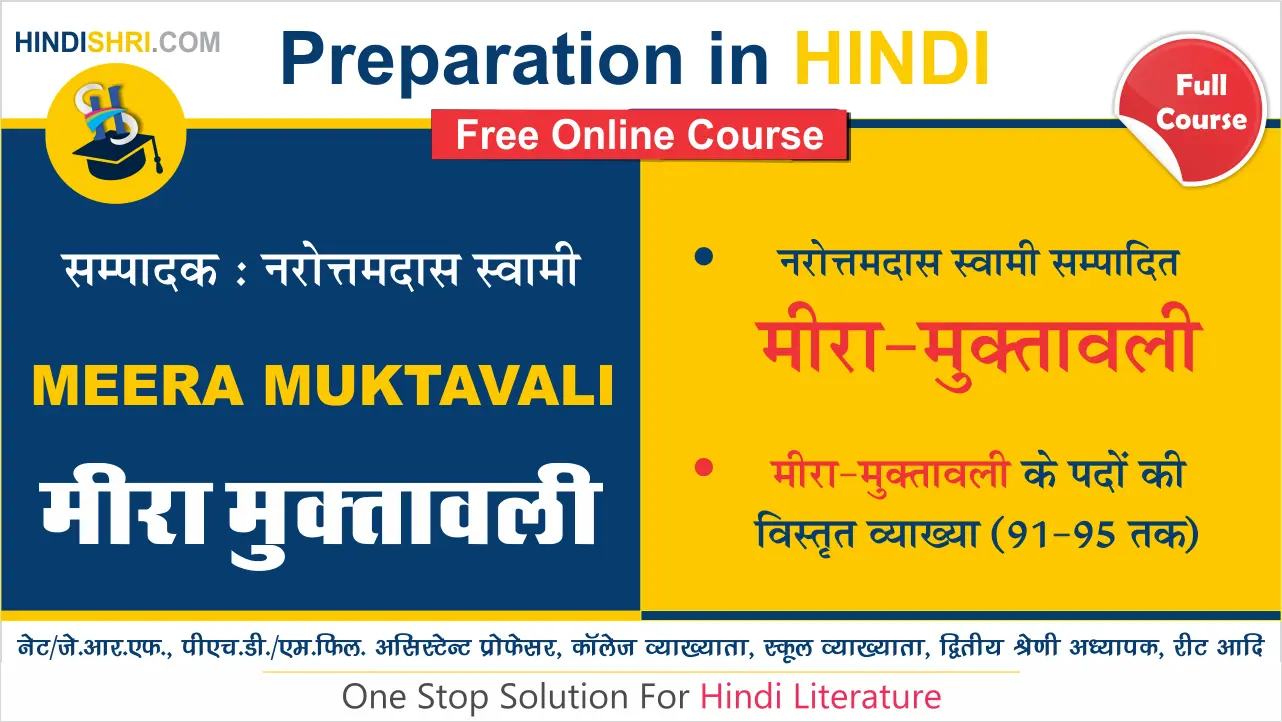
- हिंदी साहित्य का इतिहास
Meera Muktavali Explanation मीरा मुक्तावली शब्दार्थ व्याख्या (91-95)
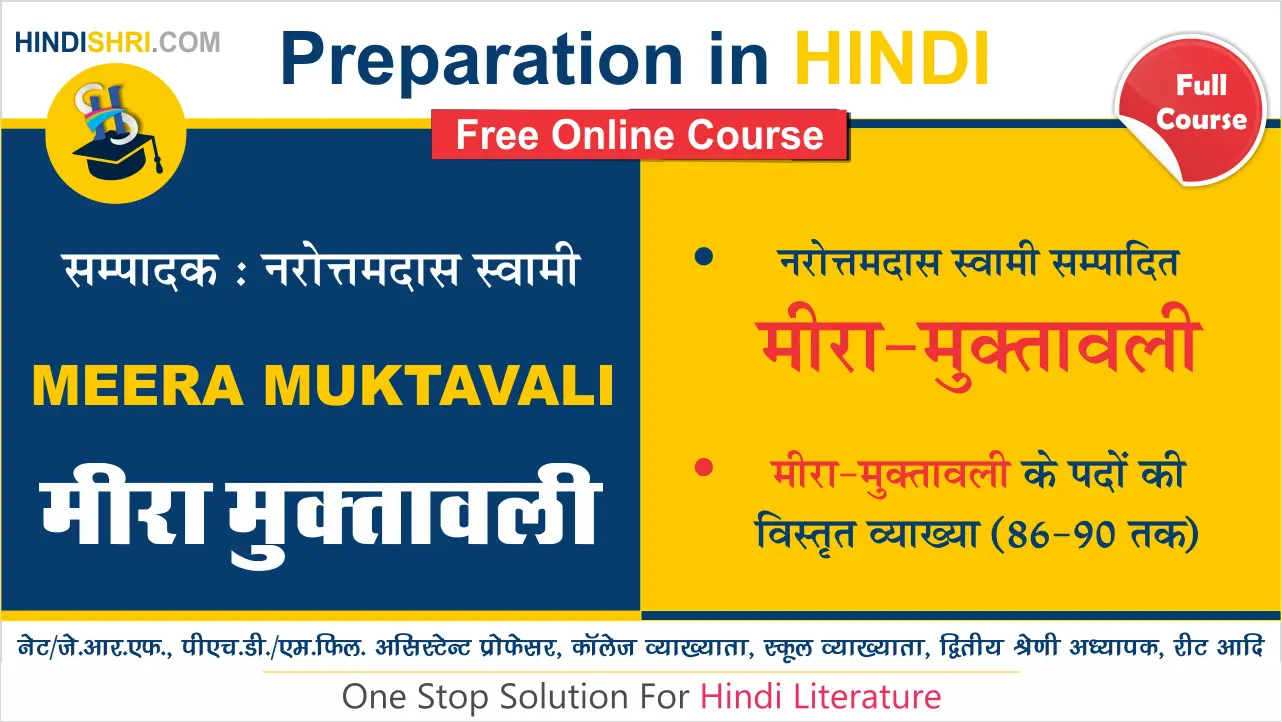
मीरा मुक्तावली का शब्दार्थ सार Meera Muktavali (86-90)
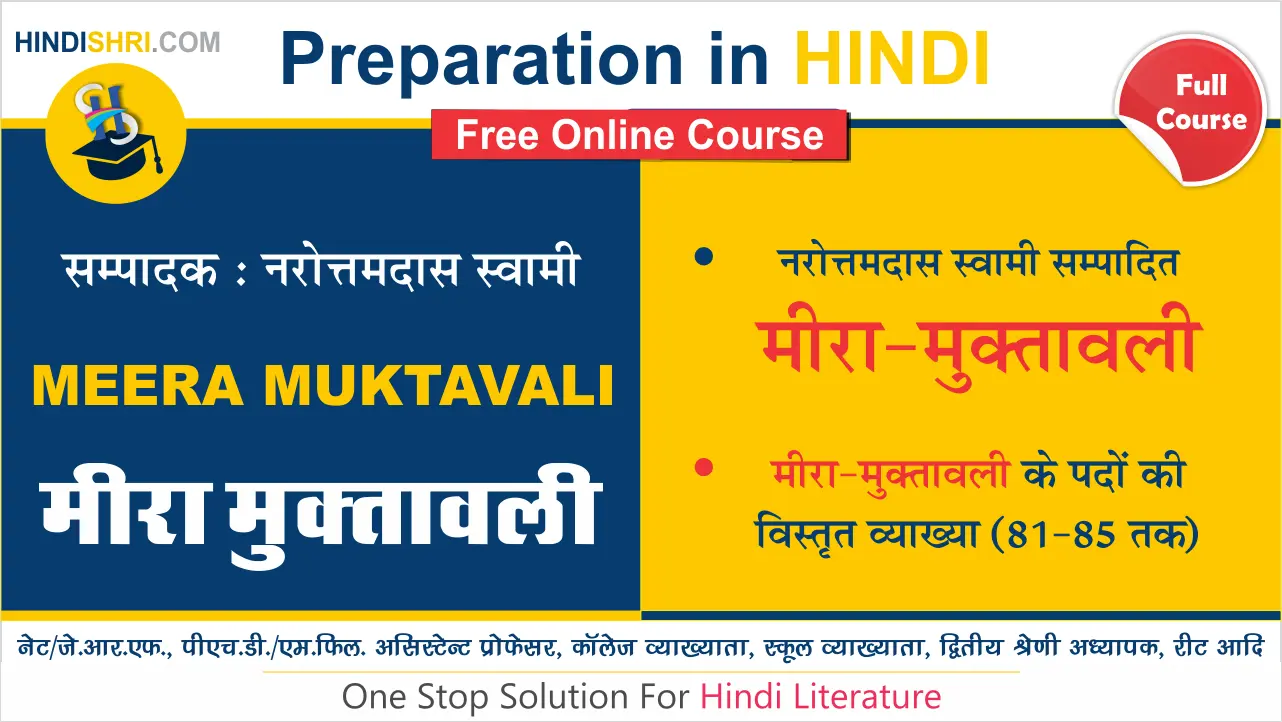
मीरा मुक्तावली का शब्दार्थ भाव Meera Muktavali (81-85)
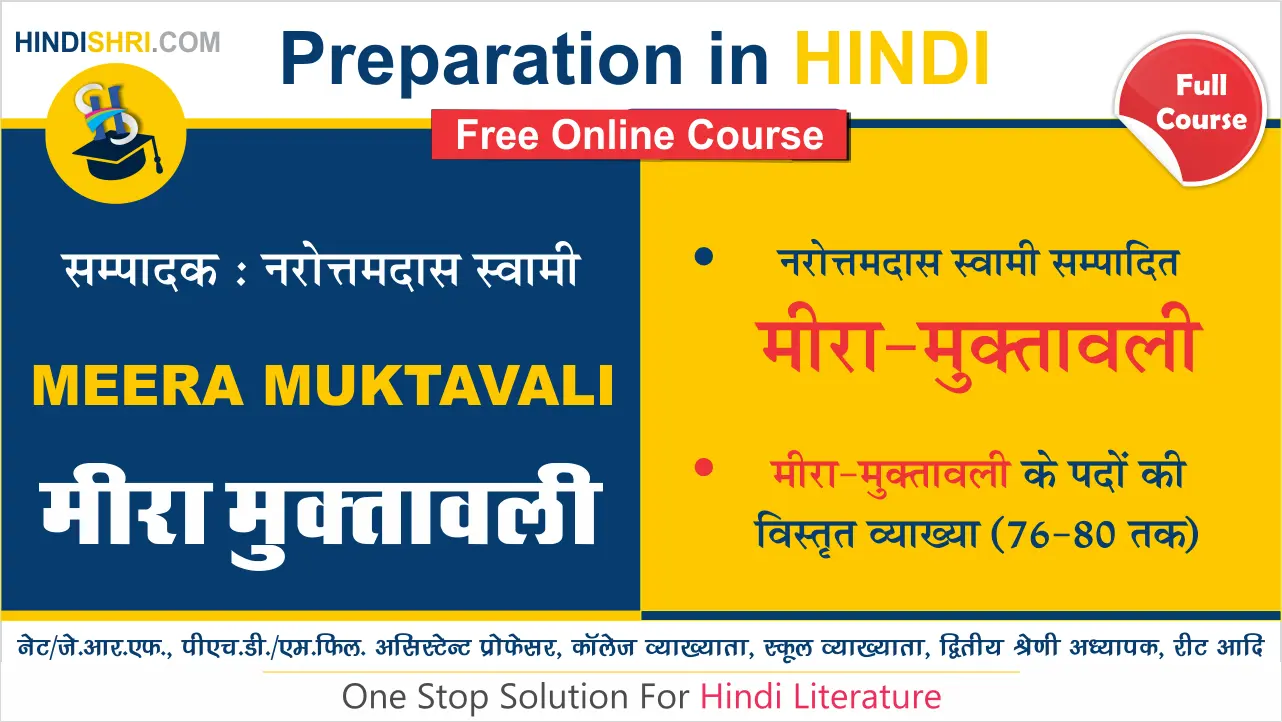
मीरा मुक्तावली शब्दार्थ व्याख्या Meera Muktavali (76-80)
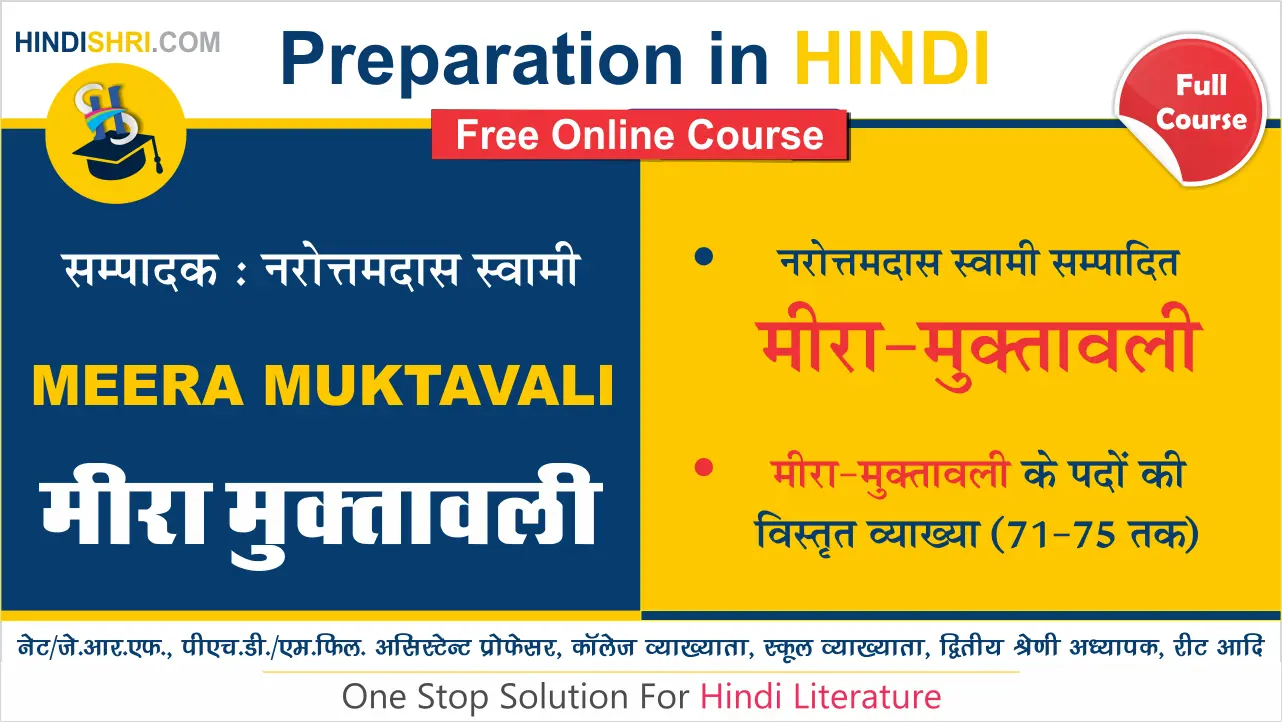
मीरा मुक्तावली के पद Meera Muktavali (71-75)
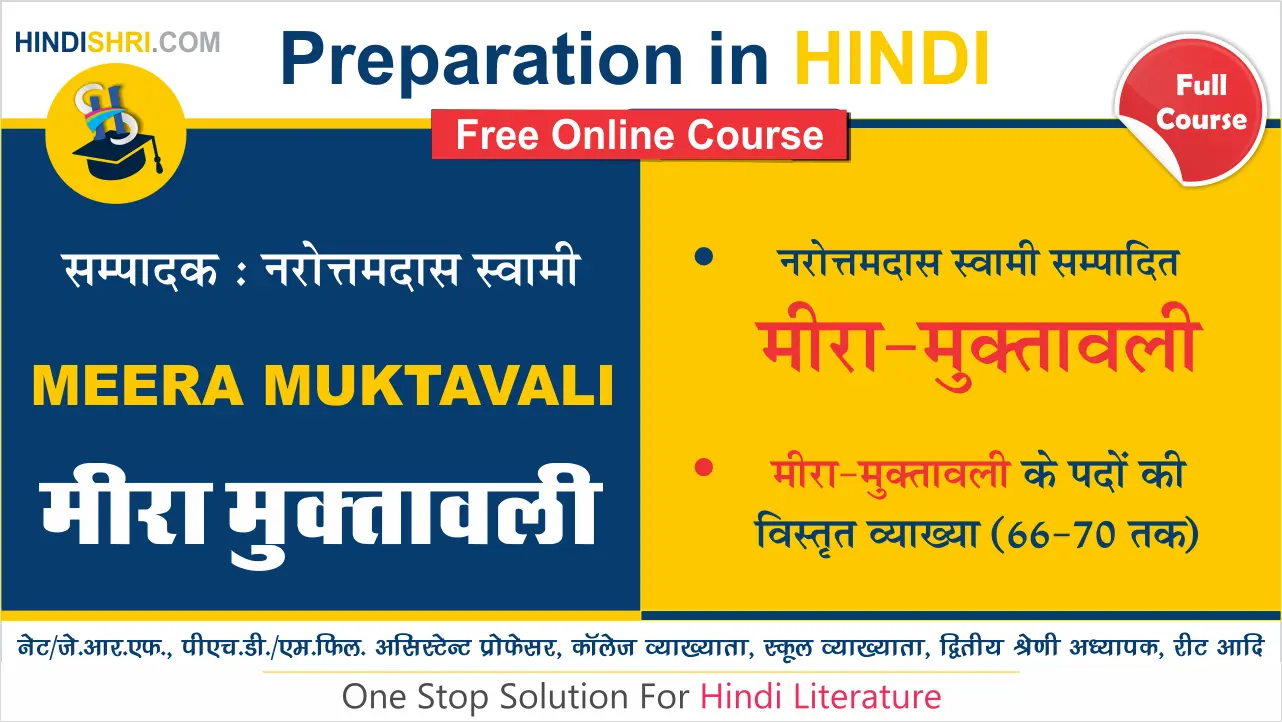
मीरा मुक्तावली का सार Meera Muktavali (66-70)
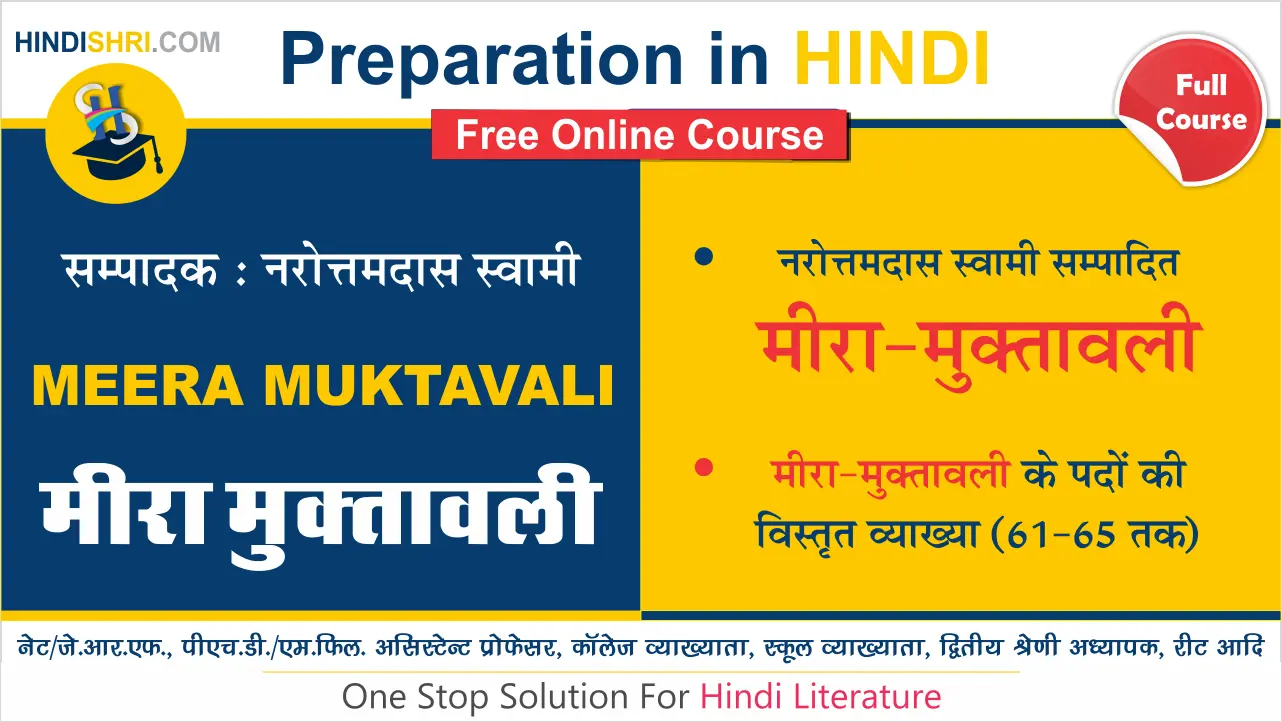
मीरा मुक्तावली का भाव Meera Muktavali (61-65)
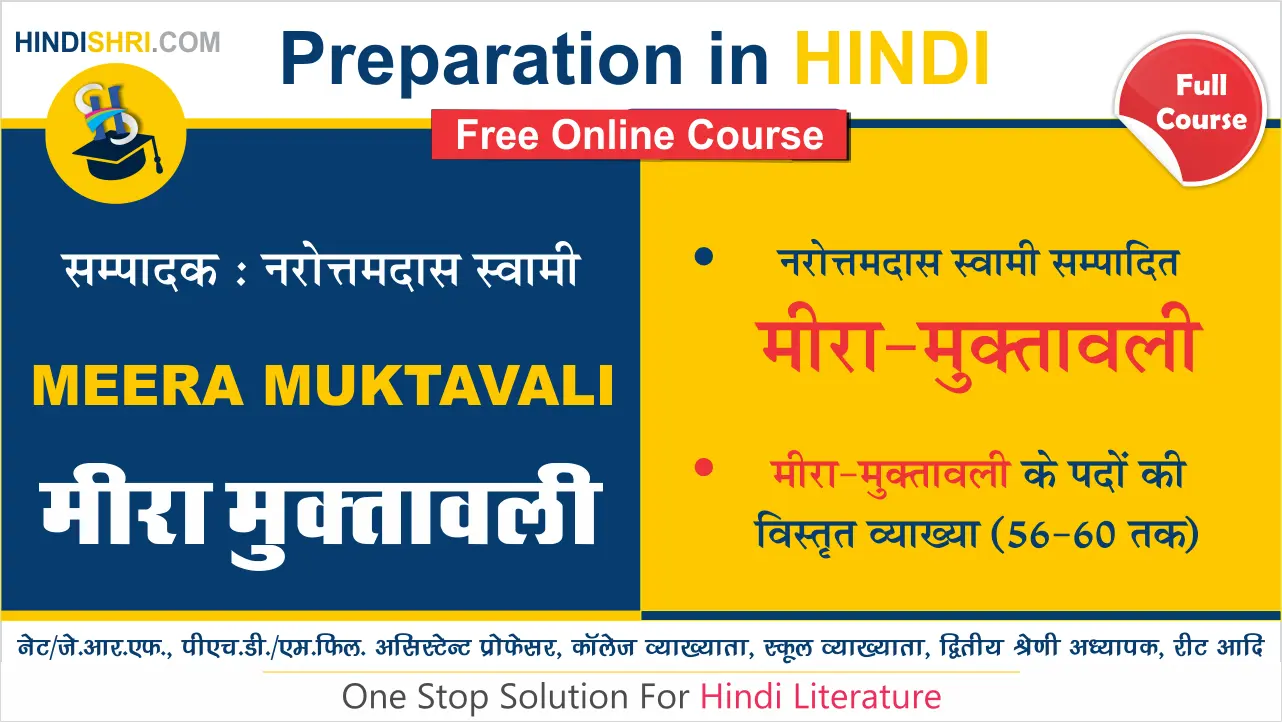

मीरा मुक्तावली का भावार्थ Meera Muktavali (56-60)
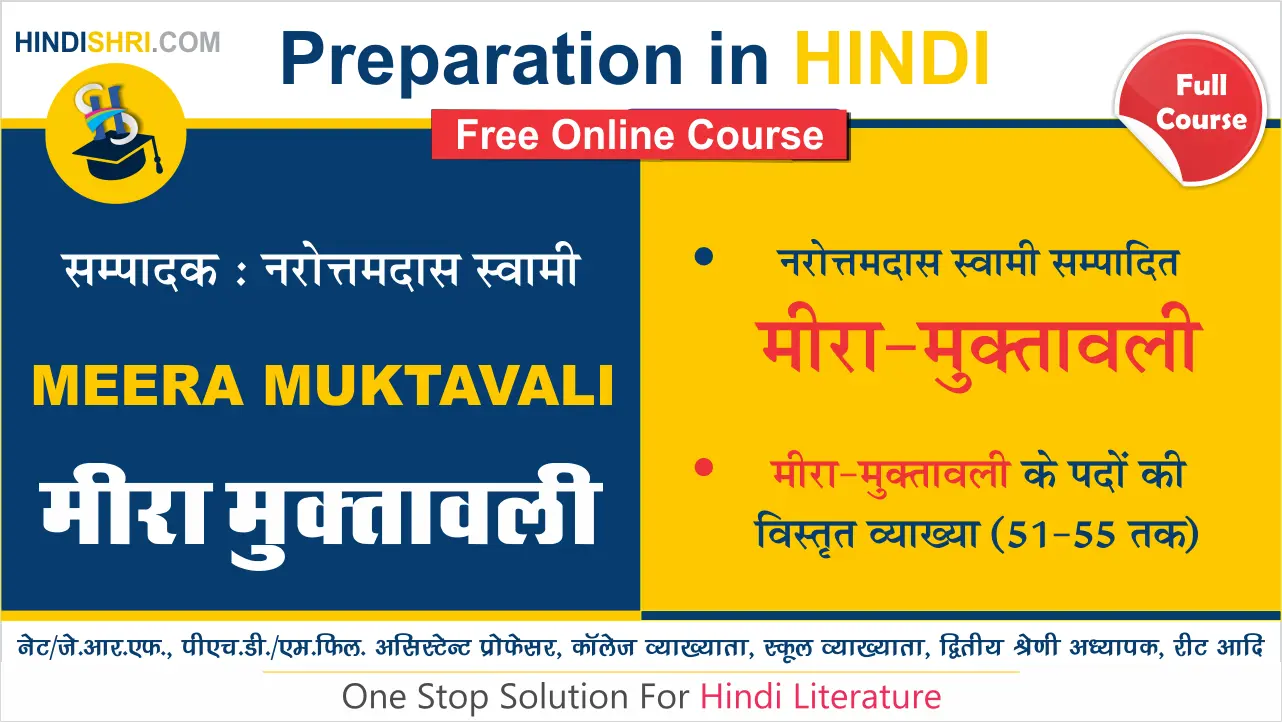
मीरा मुक्तावली का अर्थ Meera Muktavali (51-55)
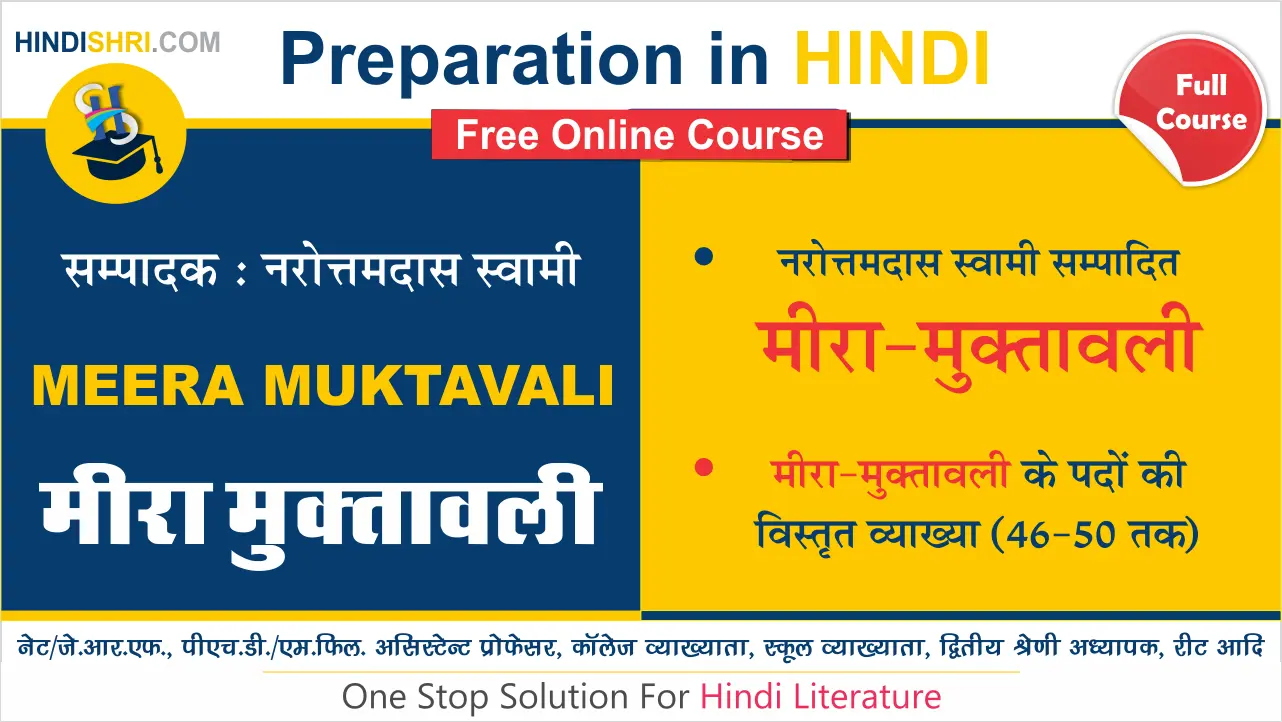
मीरा मुक्तावली की व्याख्या Meera Muktavali (46-50)
1 thought on “wordsworth | वर्ड्सवर्थ का काव्य भाषा सिद्धांत”, leave a comment cancel reply.
Save my name, email, and website in this browser for the next time I comment.
Ads Blocker Detected!!!
We have detected that you are using extensions to block ads. Please support us by disabling these ads blocker.
- Privacy Policy
- Terms and Conditions

विलियम वर्ड्सवर्थ का काव्य-भाषा सिद्धान्त | William Wordsworth ka Kavyabhasha Siddhant
विलियम वर्ड्सवर्थ का काव्य-भाषा सिद्धान्त william wordsworth ka kavyabhasha siddhant.

प्रसिद्ध अंग्रेजी कवि विलियम वर्ड्सवर्थ ( 1770-1850 ई.) एक कवि के रूप में सुविख्यात हैं। आधुनिक काल के छायावादी कवि सुमित्रानन्दन पन्त की भांति वईसवर्थ ने भी प्रकृति निरीक्षण से कविता की ओर अपने झुकाव को व्यक्त किया है। बीस वर्ष की अवस्था में वर्ड्सवर्थ ने पैदल ही फ्रान्स , इटली और आल्पस पर्वत श्रृंखला की प्राकृतिक सुषमा का अवलोकन किया और इस सौन्दर्य को अपनी काव्यवस्तु बनाया। विद्वानों का एक वर्ग यह भी मानता है कि फ्रान्स की राज्य क्रान्ति ने भी वर्ड्सवर्थ की आलोचना को प्रभावित किया।
सन् 1795 ई. में वर्ड्सवर्थ एक अन्य कवि ‘ कॉलरिज ’ के सम्पर्क में आए और दोनों ने मिलकर ऐसी नवीन रचनाएं प्रस्तुत की जो तत्कालीन युग की मांग थीं। इन दोनों की रचनाओं का संकलन ‘ लिरिकल बैलड्स ’ नामक संग्रह में 1798 ई. में प्रकाशित हुआ। इस संकलन की भूमिका ‘ एडवरटिजमेन्ट ’ नाम से वर्ड्सवर्थ ने लिखी , जिससे उस समय कॉलरिज पूर्ण रूप से सहमत थे। इस भूमिका में इस संग्रह में संकलित कविताओं की विषय-वस्तु और काव्य भाषा पर विस्तार से प्रकाश डाला गया था जिसकी तीखी आलोचना नव-अभिजात्यवादी आलोचकों ने की।
सन् 1800 ई. में ‘लिरिकल बैलड्स ’ का दूसरा संस्करण प्रकाशित हुआ जिसमें वर्ड्सवर्थ ने एक लम्बी भूमिका ‘ प्रिफेस टु लिरिकल बैलड्स ’ नाम से जोड़ी जिसमें उन्होंने अपने आलोचकों द्वारा उठाए गए प्रश्नों , शंकाओं का सटीक उत्तर दिया। अगले संस्करण में पुनः इस भूमिका में कुछ और जोड़ा गया। इस प्रकार सन् 1815 ई. तक उक्त संकलन के चार संस्करण प्रकाशित हुए।
यद्यपि वर्ड्सवर्थ द्वारा काव्यवस्तु एवं काव्यभाषा पर व्यक्त किए गए विचारों से ‘ कॉलरिज ’ प्रारम्भ में पूर्ण रूप से सहमत थे , किन्तु कालान्तर में उन्होंने 1817 ई. में अपनी प्रसिद्ध पुस्तक ‘ बायोग्राफिया लिटरेरिया ’ में वईसवर्थ के विचारों का खण्डन किया।
भले ही कॉलरिज एवं अन्य आलोचकों ने वर्ड्सवर्थ के काव्यभाषा सम्बन्धी विचारों से असहमति व्यक्त की हो , किन्तु अंग्रेजी समीक्षा में वर्ड्सवर्थ के ‘ लिरिकल बैलड्स ’ की भूमिका का महत्वपूर्ण स्थान है। वस्तुतः इस भूमिका ने काव्य की विषय-वस्तु एवं काव्यभाषा पर जो विचार व्यक्त किए वे सर्वथा नवीन एवं मौलिक थे तथा इन विचारों ने परम्परागत आधार को धक्का पहुंचाया। उन्होंने कवि , कविता , काव्य की विषय-वस्तु , काव्यप्रयोजन , काव्यभाषा पर विस्तृत विवेचन करते हुए नवीन विचार प्रस्तुत किए।
इनमें से काव्यभाषा पर व्यक्त उनके विचार सर्वाधिक महत्वपूर्ण हैं। इन विचारों को हम निम्न बिन्दुओं में भली प्रकार समझ सकते हैं :
1. वर्ड्सवर्थ ने परम्परागत काव्यभाषा एवं काव्यशैली का तीव्र विरोध किया। आधुनिक काल में जिस प्रकार टी.एस. इलियट एवं ‘ एजरा पाउण्ड ’ ने काव्य में बोलचाल की भाषा का समर्थन किया , वैसे ही वर्ड्सवर्थ ने कविता के लिए स्वाभाविक एवं प्रकृत (सहज, साधारण) भाषा का जोरदार समर्थन किया।
2. वर्ड्सवर्थ कृत्रिमता के स्थान पर सरलता को शैलीगत सौन्दर्य मानते हैं। उन्होंने कृत्रिम भाषा को त्यागकर सरल भाषा पर बल दिया। उनसे पूर्व कवियों ने भाषा को अस्वाभाविक , बोझिल , आडम्बरपूर्ण एवं कृत्रिम बना दिया था जिसका पुरजोर विरोध वर्ड्सवर्थ ने किया।
3. वर्ड्सवर्थ ने काव्य की विषय-वस्तु के लिए जिस प्रकार ग्रामीण जीवन का समर्थन किया , उसी प्रकार ग्रामीण जीवन की दैनिक बोलचाल की भाषा का काव्य में प्रयोग करने का समर्थन किया। उनकी मान्यता है कि ग्रामीणों की अभिव्यक्ति सरल , अकृत्रिम एवं स्वच्छन्द होती है। उनकी वाणी में सच्चाई तथा भावों में सरलता रहती है , अतः इसी भाषा को काव्य में प्रयुक्त करना चाहिए।
4. वर्ड्सवर्थ ने गद्य और पद्य में समान भाषा के प्रयोग की वकालत की। उनकी यह मान्यता भाषा सम्बन्धी अतिवादिता (अमर्यादित, वाचालता) का परिचय देती है , क्योंकि गद्य-पद्य का अन्तर केवल छन्द के कारण ही नहीं होता अपितु वाक्य-विन्यास , पद-चयन , आलंकारिकता आदि के कारण भी होता है।
5. वईसवर्थ कविता को “ Spontaneous overflow of powerful feelings” अर्थात् “प्रबल भावावेगों का स्वच्छन्द प्रवाह” मानते थे। प्रबल भावों की भाषा स्वतः ही भव्य , सजीव एवं चित्रात्मक होगी।
6. वईसवर्थ की धारणा थी कि कृत्रिम भाषा निम्न श्रेणी के कवियों की देन है। जब कवि वास्तविक घटनाओं से उद्बुद्ध (जागृत) भावों को काव्य में निबद्ध (सँजोता, गुँथना) करता है तब भावों की प्रबलता के कारण भाषा सहज रूप में प्रभावी और अलंकृत होती है।
7. जब कोई कवि यश की कामना से काव्य रचना करता है तब भाषा में आडम्बर , कृत्रिमता , समास , अलंकार , जटिलता , उक्ति वैचित्र्य (अभिव्यक्ति का चमत्कार) आदि का समावेश होता है। यह भाषा सहज नहीं होती अतः काव्य के लिए इसे वईसवर्थ अनुपयुक्त बताते हैं।
8. वईसवर्थ यद्यपि छन्द को कविता के लिए अनिवार्य नहीं मानते तथापि छन्द की महत्ता एवं शक्ति को स्वीकार करते हैं। उनके विचार से छन्दयुक्त होने पर कविता सम , सन्तुलित एवं आनन्दप्रद बन जाती है। छन्द विषय के उपयुक्त होना चाहिए तभी प्रभावी कविता बनती है।
वर्ड्सवर्थ के भाषा सम्बन्धी विचारों की आलोचना :
कॉलरिज ने अपने ग्रन्थ ‘ बायोग्राफिया लिटरेरिया ’ में वईसवर्थ की विचारधारा की आलोचना करते हुए जो तर्क दिए वे इस प्रकार हैं:
1. कॉलरिज के अनुसार ग्रामीण भाषा की शब्दावली अपर्याप्त और कामचलाऊ होती है उसमें काव्य की गहन , सूक्ष्म एवं विविध अनुभूतियों को व्यक्त कर सकने की क्षमता नहीं होती।
इस सम्बन्ध में यह कहना उपयुक्त है कि वईसवर्थ ग्रामीण भाषा के प्रति दुराग्राही नहीं थे। उनका कथन था कि कवि को यथासम्भव ग्रामीण भाषा का प्रयोग करना चाहिए।
2. वर्ड्सवर्थ काव्य में उस भाषा के प्रयोग पर बल देते हैं जो ‘ मनुष्यों की वास्तविक भाषा ’ है , अर्थात् वे कृत्रिमता से बचने की बात कहते हैं , किन्तु कॉलरिज का मत है कि प्रत्येक मनुष्य की भाषा उसके ज्ञान , क्रिया , सम्वेदना , शिक्षा के स्तर आदि के कारण भिन्न-भिन्न प्रकार की होती है। अतः काव्य भाषा में स्वाभाविक भाषा का प्रयोग न होकर उस भाषा का प्रयोग होता है जो संस्कार रूप में कवि के मन पर अपना प्रभाव डाले रहती है।
3. वईसवर्थ का यह भी कहना था कि ग्रामीण भाषा के दोषों को दूर करके उसमें से उन शब्दों को निकाल देना चाहिए जो अरुचि और जुगुप्सा (घृणा) उत्पन्न करने वाले हों। इस सम्बन्ध में कॉलरिज का कथन है कि जब ग्रामीण भाषा को दोषों से मुक्त करके परिष्कृत कर लिया गया हो , तो वह ग्रामीण भाषा कहाँ रहती है।
इस सम्बन्ध में यही कहना उचित है कि वईसवर्थ ने ग्रामीण भाषा का समर्थन करते हुए कवियों का रुझान ग्रामीण भाषा की ओर करने का प्रयास किया है।
4. कॉलरिज यह भी मानते हैं कि भावों के प्रबल आवेग की दशा में या तीव्र अनुभूति की दशा में वे ही शब्द कवि को सूझते हैं जो पहले से मन में विद्यमान हों और असाधारण उत्तेजना से वे उत्पन्न हो जाते हैं।
वईसवर्थ का कहना है कि काव्य में प्रयुक्त शब्द अलौकिक नहीं होते , वे बोलचाल की भाषा से ही गृहीत होते हैं , लेकिन इस अवस्था में प्रयुक्त होने पर अधिक भाव-व्यंजक (स्पष्ट भाव प्रकट करने वाला) हो जाते हैं।
5. कॉलरिज ने गद्य और पद्य की भाषा की एकरूपता का भी विरोध किया उनके अनुसार – “कोई शब्द या शब्द क्रम केवल गद्य के लिए होता है , तो कोई पद्य के लिए।” इसलिए गद्य और पद्य की भाषा में अभेद स्वीकार्य नहीं है।
निष्कर्ष
इस प्रकार विलियम वर्ड्सवर्थ ने काव्यभाषा के संबंध में तीन प्रमुख मान्यताएँ प्रतिपादित की :
1. कविता में बोलचाल की भाषा का प्रयोग होना चाहिए। उन्होंने कवियों को यह सलाह दी कि उन्हें यथासंभव जनसामान्य की भाषा को अपना लेना चाहिए।
2. गद्य और काव्य की भाषा में कोई तात्विक अंतर नहीं होता ।
3. प्राचीन कवियों के उद्गारों में सहजता थी । इसी कारण भाषा सरल थी एवं उसमें आडंबर एवं बनावटीपन नहीं था ।
वर्ड्सवर्थ के अनुसार कवि के हृदय में यदि भाव का उन्मेष (भाव प्रकट होना) है और विषय का चयन ठीक हुआ है तो भाषा स्वयं ही उसके अनुरूप आकार ग्रहण कर लेगी। उनकी यह धारणा थी कि शब्द अपने आप में काव्यात्मक या अकाव्यात्मक नहीं होते , भाषा प्रयोग के आधार पर वे अपना स्वरूप अर्जित करते हैं ।
अतः उक्त विवेचन के आधार पर यह कहा जा सकता है कि वईसवर्थ के काव्यभाषा सम्बन्धी विचार निश्चित ही मौलिक एवं नवीन हैं। वस्तुतः वह काव्य में आडम्बरपूर्ण भाषा के विरोधी थे और सरल , सहज , ग्रामीण भाषा के पक्षधर थे जो अकृत्रिम एवं प्रकृत (सहज, साधारण) होती है। वर्ड्सवर्थ ने काव्य में ‘ कल्पना शक्ति ’ पर विशेष बल दिया और काव्य में भाव-तत्व को प्रतिष्ठित किया। यह निःसंकोच कहा जा सकता है कि एक महाकवि की अन्तर्दृष्टि (मन की बात समझने की शक्ति, ज्ञानचक्षु ,प्रज्ञा) वर्ड्सवर्थ के विचारों में विद्यमान थी , भले ही उनके विचारों का पर्याप्त विरोध कॉलरिज एवं अन्य आलोचकों ने किया हो।
Related Posts
Post a comment, कोई टिप्पणी नहीं.
Please do not enter any spam link in the comment box.
- मुख्यपृष्ठ
- छायावाद
- पाश्चात्य काव्यशास्त्र
- प्रयोजनमूलक हिंदी
- भारतीय काव्यशास्त्र
- विविध विषय
- शोध और अनुसंधान
- हिंदी आलोचना
- हिंदी नाटक और एकाँकी
- हिंदी साहित्य
मेरे बारे में
Please Subscribe My You Tube Channel
Popular posts.

Recent Posts
Random posts.
William Wordsworth
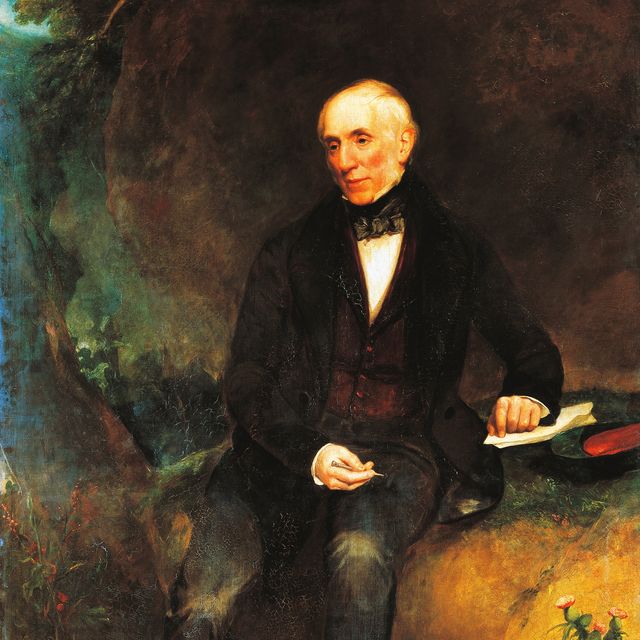
(1770-1850)
Who Was William Wordsworth?
Poet William Wordsworth worked with Samuel Taylor Coleridge on Lyrical Ballads (1798). The collection, which contained Wordsworth's "Tintern Abbey," introduced Romanticism to English poetry. Wordsworth also showed his affinity for nature with the famous poem "I Wandered Lonely as a Cloud." He became England's poet laureate in 1843, a role he held until his death in 1850.
Poet William Wordsworth was born on April 7, 1770, in Cockermouth, Cumberland, England. Wordsworth’s mother died when he was 7, and he was an orphan at 13. Despite these losses, he did well at Hawkshead Grammar School — where he wrote his first poetry — and went on to study at Cambridge University. He did not excel there, but managed to graduate in 1791.
Wordsworth had visited France in 1790 — in the midst of the French Revolution — and was a supporter of the new government’s republican ideals. On a return trip to France the next year, he fell in love with Annette Vallon, who became pregnant. However, the declaration of war between England and France in 1793 separated the two. Left adrift and without income in England, Wordsworth was influenced by radicals such as William Godwin.
In 1795, Wordsworth received an inheritance that allowed him to live with his sister, Dorothy. That same year, Wordsworth met Samuel Taylor Coleridge. The two became friends, and together worked on Lyrical Ballads (1798). The volume contained poems such as Coleridge's "Rime of the Ancient Mariner" and Wordsworth's "Tintern Abbey," and helped Romanticism take hold in English poetry.
The same year that Lyrical Ballads was published, Wordsworth began writing The Prelude , an epic autobiographical poem that he would revise throughout his life (it was published posthumously in 1850). While working on The Prelud e, Wordsworth produced other poetry, such as "Lucy." He also wrote a preface for the second edition of Lyrical Ballads ; it described his poetry as being inspired by powerful emotions and would come to be seen as a declaration of Romantic principles.
"Though nothing can bring back the hour, Of splendour in the grass, of glory in the flower." -- from Intimations of Immortality from Recollections of Early Childhood
In 1802, a temporary lull in fighting between England and France meant that Wordsworth was able to see Vallon and their daughter, Caroline. After returning to England, he wed Mary Hutchinson, who gave birth to the first of their five children in 1803. Wordsworth was also still writing poetry, including the famous "I Wandered Lonely as a Cloud" and "Ode: Intimations of Immortality." These pieces were published in another Wordsworth collection, Poems, in Two Volumes (1807).
Evolving Poetry and Philosophy
As he grew older, Wordsworth began to reject radicalism. In 1813, he was named as a distributor of stamps and moved his family to a new home in the Lake District. By 1818, Wordsworth was an ardent supporter of the conservative Tories.
Though Wordsworth continued to produce poetry — including moving work that mourned the deaths of two of his children in 1812 — he had reached a zenith of creativity between 1798 and 1808. It was this early work that cemented his reputation as an acclaimed literary figure.
In 1843, Wordsworth became England's poet laureate, a position he held for the rest of his life. At the age of 80, he died on April 23, 1850, at his home in Rydal Mount, Westmorland, England.
QUICK FACTS
- Name: William Wordsworth
- Birth Year: 1770
- Birth date: April 7, 1770
- Birth City: Cockermouth, Cumberland, England
- Birth Country: United Kingdom
- Gender: Male
- Best Known For: At the end of the 18th century, poet William Wordsworth helped found the Romantic movement in English literature. He also wrote "I Wandered Lonely as a Cloud."
- Fiction and Poetry
- Astrological Sign: Aries
- Cambridge University
- Death Year: 1850
- Death date: April 23, 1850
- Death City: Rydal Mount, Westmorland, England
- Death Country: United Kingdom
CITATION INFORMATION
- Article Title: William Wordsworth Biography
- Author: Biography.com Editors
- Website Name: The Biography.com website
- Url: https://www.biography.com/authors-writers/william-wordsworth
- Access Date:
- Publisher: A&E; Television Networks
- Last Updated: October 27, 2021
- Original Published Date: April 2, 2014
Watch Next .css-smpm16:after{background-color:#323232;color:#fff;margin-left:1.8rem;margin-top:1.25rem;width:1.5rem;height:0.063rem;content:'';display:-webkit-box;display:-webkit-flex;display:-ms-flexbox;display:flex;}

Famous British People

Mick Jagger

Agatha Christie

Alexander McQueen

The Real Royal Scheme Depicted in ‘Mary & George’

William Shakespeare

Anya Taylor-Joy

Kate Middleton, Princess of Wales

Kensington Palace Shares an Update on Kate

Prince William

Where in the World Is Kate Middleton?
Biography Online

William Wordsworth Biography
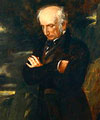
Early life – William Wordsworth
Wordsworth was born on 7 April 1770 in Cockermouth, in north-west England. His father, John Wordsworth, introduced the young William to the great poetry of Milton and Shakespeare , but he was frequently absent during William’s childhood. Instead, Wordsworth was brought up by his mother’s parents in Penrith, but this was not a happy period. He frequently felt in conflict with his relations and at times contemplated ending his life. However, as a child, he developed a great love of nature, spending many hours walking in the fells of the Lake District. He also became very close to his sister, Dorothy, who would later become a poet in her own right.
In 1778, William was sent to Hawkshead Grammar School in Lancashire; this separated him from his beloved sister for nearly nine years. In 1787, he entered St. John’s College, Cambridge. It was in this year that he had his first published work, a sonnet in the European Magazine . While still a student at Cambridge, in 1790, he travelled to revolutionary France. He was deeply impressed by the revolutionary spirit and the principles of liberty and egalite. He also fell in love with a French woman, Annette Vallon; together they had an illegitimate daughter, Anne Caroline.
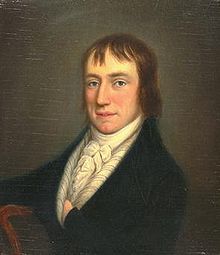
Friendship with Samuel Taylor Coleridge
After graduating, Wordsworth was fortunate to receive a legacy of £900 from Raisley Calvert to pursue a career in literature. He was able to publish his first collection of poems, An Evening Walk and Descriptive Sketches . That year he was also to meet Samuel Taylor Coleridge in Somerset. They became close friends and collaborated on poetic ideas. They later published a joint work – Lyrical Ballards (1798), and Wordsworth greatest work ‘ The Prelude ‘ was initially called by Wordsworth ‘ To Coleridge ‘
This period was important for Wordsworth and also the direction of English poetry. With Coleridge , Keats and Shelley , Wordsworth helped create a much more spontaneous and emotional poetry. It sought to depict the beauty of nature and the quintessential depth of human emotion. In the preface to Lyrical Ballards , Wordsworth writes of poetry:
“The spontaneous overflow of powerful feelings: it takes its origin from emotion recollected in tranquility.”
Lyrical Ballards includes some of his best-known poems, such as, “Lines Composed a Few Miles above Tintern Abbey”, “A Slumber Did my Spirit Seal”.
A SLUMBER did my spirit seal; I had no human fears: She seemed a thing that could not feel The touch of earthly years. No motion has she now, no force; She neither hears nor sees; Rolled round in earth’s diurnal course, With rocks, and stones, and trees.
– W. Wordsworth 1799.
In 1802, after returning from a brief visit to see his daughter, Wordsworth married a childhood friend, Mary Hutchinson. Dorothy continued to live with the couple, and she became close to Mary as well as her brother. William and Mary had five children, though three died early.
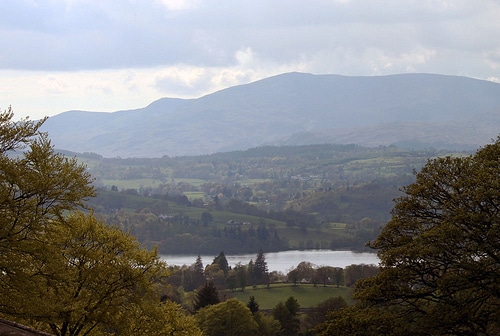
Lake District, North Windermere, near Grasmere.
In 1807, he published another important volume of poetry “ Poems, in Two Volumes “, this included famous poems such as; “I Wandered Lonely as a Cloud”, “My Heart Leaps Up”, “Ode: Intimations of Immortality.”
I wandered lonely as a cloud That floats on high o’er vales and hills, When all at once I saw a crowd, A host, of golden daffodils;
– W. Wordsworth – I Wandered Lonely as a Cloud
In 1813, he received an appointment as Distributor of Stamps for Westmorland; this annual income of £400 gave him greater financial security and enabled him to devote his spare time to poetry. In 1813, he family also moved into Rydal Mount, Grasmere; a picturesque location, which inspired his later poetry.
“My heart leaps up when I behold A rainbow in the sky: So was it when my life began; So is it now I am a man; So be it when I shall grow old, Or let me die!”
Poet Laureate
By the 1820s, the critical acclaim for Wordsworth was growing, though ironically critics note that, from this period, his poetry began losing some of its vigour and emotional intensity. His poetry was perhaps a reflection of his own ideas. The 1790s had been a period of emotional turmoil and faith in the revolutionary ideal. Towards the end of his life, his disillusionment with the French Revolution had made him more conservative in outlook. In 1839 he received an honorary degree from Oxford University and received a civil pension of £300 a year from the government. In 1843, he was persuaded to become the nation’s Poet Laureate, despite saying he wouldn’t write any poetry as Poet Laureate. Wordsworth is the only Poet Laureate who never wrote poetry during his official time in the job.
Wordsworth died of pleurisy on 23 April 1850. He was buried in St Oswald’s Church Grasmere. After his death, his widow Mary published his autobiographical ‘Poem to Coleridge’ under the title “The Prelude”.
Citation: Pettinger, Tejvan . “ Biography of William Wordsworth” , Oxford, UK. www.biographyonline.net , 22nd Jan. 2010. Last updated 6th March 2018
William Wordsworth – The Major Works

William Wordsworth – The Major Works at Amazon
Related pages
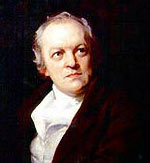
External links
- William Wordsworth at Amazon.co.uk
- William Wordsworth at Amazon.com
- Wordsworth.org.uk
- William Wordsworth profile at BBC

William Wordsworth: Biography, books, poems

Table of Contents
William Wordsworth, an English poet, was a key figure in the Romantic movement. He and another poet, Samuel Taylor Coleridge, wrote a book called “Lyrical Ballads” in 1798. This unintentionally marked the beginning of the Romanticism era in English literature.
Fill Out the Form for Expert Academic Guidance!
Please indicate your interest Live Classes Books Test Series Self Learning
Verify OTP Code (required)
I agree to the terms and conditions and privacy policy .
Fill complete details
Target Exam ---
William Wordsworth grew up in an English valley known for its peaceful lakes, mountains, and forests. These natural surroundings would later inspire his writing. Spending time in nature enriched him the most, shaping his mindset and work. Continue reading the ensuing article to learn further details about his life chronology.
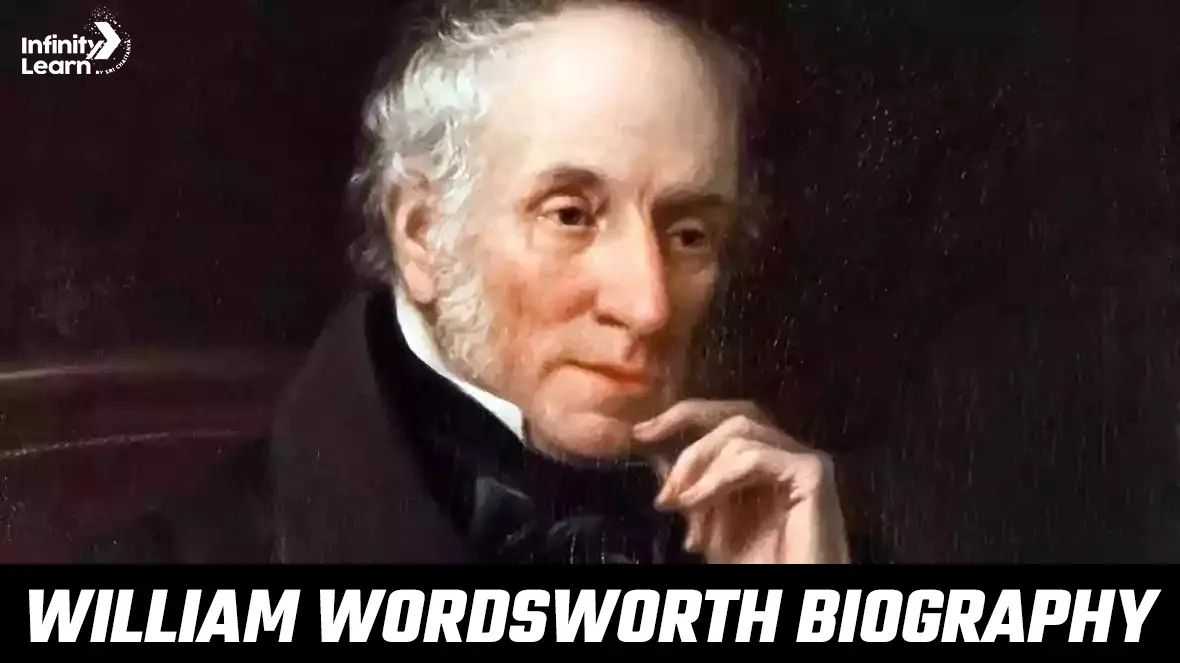
William Wordsworth Biography – Early Life
The famous poet William Wordsworth was born in Cockermouth, Cumbria on April 7, 1770. His dear father also worked as a lawyer.
At first, there was some good news in the restructuring. Different relatives took care of him and his siblings when he was 15 because both parents had passed away. From a young age, Wordsworth had a deep love for nature that inspired his work.
In his study time at Cambridge University, he used a summer term break to move-about on foot through Switzerland and France. There he made his appreciation of the French Revolution’s ideals. He has shown a talent for poetry since school, but people did not recognize his works until 1793.
Also Read: Biography Lists
William Wordsworth Education
Wordsworth’s mother, Ann Cookson, educated him at home and gave him his first lessons. He started school at eight in Hawkshead Grammar School, a grammar school in the English village of Hawkshead in Lake Land. They taught the essential education with literature, Latin, and Greek here.
In 1787, what was then 17 years old, moved on to his most renowned university St. John’s College, Cambridge. The audience in Cambridge did not support him. He realized that the academic environment of the university was not a good fit for his artistic nature.
Wordsworth spent most of his time observing nature by taking long walks in the countryside instead of being in the city. This had a significant influence on his poetry. This later influenced his poetry significantly.
Wordsworth loved books and nature, finding them both to be sources of knowledge and inspiration. He wrote special songs about nature, drawing from his personal experiences and emotions, both happy and sad.
Wordsworth and Coleridge, both famous Romantic poets, worked together and greatly influenced each other’s education and lives. Combined, they were able to publish an epic and famous collection of poems titled “Lyrical Ballads” in the 1798-year. The collection focused on current issues, used simple language, and expressed emotions. It showed a unique and significant change in English poetry.

William Wordsworth Biography – Career
William’s poetry talent emerged during his time at Hawkshead Grammar School, showcasing his natural ability from a young age. In 1787, he started his poetry career with his sonnet being the first to appear in the Magazine Europoric.
His time at St John’s College, Cambridge, as well as his travels around Europe, greatly influenced his personal growth and worldview. His voyages helped him grow personally, change his interests, and expand his worldview. He saw the struggles of ordinary people and it inspired his poetry.
In 1793, he gained recognition for his collection of poems. They called the collection ‘An Evening Walk and Descriptive Sketch.’ This recognition helped advance his career.
In 1795 he encountered a writer and poet Samuel Taylor Coleridge. In 1798, they collaborated on “Lyrical Ballads”, a book that helped make the English Romantic Movement famous.
Maximum heights in his career he got in 1807 when he brought out the following books: ‘Poems, in Two Volumes. He had his first hit with ‘The Lyrical Ballads’ in 1798. After that, he wrote ‘Guide to the Lakes’ in 1810, ‘The Excursion’ in 1814, and ‘Laodamia’ in 1815.
William Wordsworth Poem
William Wordsworth, definitely the most renowned poem writer of his generation, had different milestones through his poetry career. Here are some of his notable achievements:Here are some of his notable achievements:
- Lyrical Ballads (1798): Nelimyanuyu yakanelstvo t’ma mantsoqupuschetsi zi Samuel Taylor Coleridge, otorom on obtsenyvaet status vashlyutyerevskovykh lietensidei v angliskom yazyke. The theme of the book was different from the classical style, and authors such as Jane Austen got rid of the ancient themes and usage of complex words. As a major change the emotional content of the book is emphasised, it defies the routine and simple way of depicting lives of ordinary people.
- The Prelude (1850): This poem, sonnet form that he wrote and that his wife Mary published after his death, is considered to be one the best words of the poet. It presents thus the poet’s biography, his growing into a writer, and his own philosophical thoughts about the nature and human race.
- Poet Laureate (1843): Though a Poet Laureate was supposed to be critic and satirist, Wordsworth was appointed Poet Laureate of the United Kingdom in 1843 and he held the position until his death in 1850. Despite no official verses being composed by him while he was in position, his appointment was an indication of his influence and good deeds as a poet.
- Influence on the Romantic Movement: The Romanticism was notably marked with Wordsworth’s focus on nature, feeling, and the sublime which played too vivid a part in the movement to be ignored. The impact of his works is vividly demonstrated by the fact that he was a model of emulation of numerous poets and writers of his time, having inspired English literature.
- Famous Poems : Congratulations are due to Wordsworth who wrote memorable poems, e. g. , “Lined Composed a Few Miles above Tintern Abbey,” “I Wandered Lonely as a Cloud,” “Ode: On Intimations of Immortality,” “The Solitary Reaper,” and “The World Is Too Much with Us. “These poems are remembered for their lyrical, [and] aesthetic appeal and their subtle, yet, profound introspection on nature and humanity. “
- Promotion of Ordinary Life in Poetry: Wordsworth’s poetry frequently inspired him to give a new outlook to the lives of the common people, marking them as the worthiest themes. It was a turning point, an essence of which was poetry becoming democratic, easily grasped by ordinary folks.
William Wordsworth Death and Legacy
William Wordsworth passed away from pleurisy on April 23, 1850, at Rydal Mount in Westmorland, England. They laid him to rest in St. Oswald’s Church in Grasmere. Shortly after his death, his wife Mary published “The Prelude,” also known as Poem to Coleridge. Wordsworth did not write any official poems during his time as poet laureate. He was the only one to do so. His term began in 1843.

FAQs on William Wordsworth Biography
Who is william wordsworth.
William Wordsworth was born on April 7, 1770, in Cockermouth, Cumbria. His father, a lawyer, passed away while Wordsworth was still young. Tragically, both of his parents had died by the time he was 15, leaving him and his four siblings to be cared for by various relatives. During his youth, Wordsworth developed a deep love for nature, a theme that would prominently feature in many of his poems.
Why is Wordsworth so famous?
Wordsworth is best known for Lyrical Ballads, which he co-wrote with Samuel Taylor Coleridge, and The Prelude, a Romantic epic poem that chronicles the growth of a poet's mind.
How many poems did Wordsworth write?
William Wordsworth wrote an 387 poems during his lifetime.
Why is Wordsworth called a romantic poet?
William Wordsworth is a pivotal figure in Romantic poetry, as his work and philosophy embody the core ideals of the Romantic Movement.
Related content
Talk to our academic expert!
Language --- English Hindi Marathi Tamil Telugu Malayalam
Get access to free Mock Test and Master Class
Register to Get Free Mock Test and Study Material
Offer Ends in 5:00

IMAGES
VIDEO
COMMENTS
:विलियम वर्द्स्वर्थ will return a person's date of birth. Using this template rather than simply inserting the date into articles ...
William Wordsworth (7 April 1770 - 23 April 1850) was an English Romantic poet who, with Samuel Taylor Coleridge, helped to launch the Romantic Age in Englis...
विलियम वर्ड्सवर्थ की जीवनी - Biography of William Wordsworth in Hindi Jivani. Published By : Jivani.org. • नाम : विलियम वर्ड्सवर्थ ।. • जन्म : 7 अप्रैल 1770, कॉकमार्क, कम्बरलँड, इंग्लंड ...
2-William Wordsworth (आप प्रकृति के महान कवि हुए) 3-Dorothy Wordsworth आपकी बहन, आपसे 1 साल छोटी और सबसे प्रिये) 4-John Wordsworth (Earl of Abergavenny के कैप्टन थे, जो1805 में पानी वाली ...
Literature Notes for UP - TGT/PGT/LT Grade Available. Call 9368000671to Join us to Telegram - TGT/PGT (Sub English - Target 2021https://t.me/sameer_pathshala...
William Wordsworth, biography, facts, daffodil & poems in hindi. उल्लेखनीय कार्य: "Lines a Few Miles Above Tintern Abbey" "Lyrical Ballad" "Michael" "Ode: Notice of Immortality" "Peter Bell" "Excursion" "Prologue" "The Recluse" "The Ruined Cottage" The Solitary Reaper" "The World Is Too Much With Us"
Complete William Wordsworth in Hindi ||All works of William Wordsworth ||Complete William Wordsworth in Hindi ||All works of William Wordsworth || This lectu...
William Wordsworth (7 April 1770 - 23 April 1850) was an English Romantic poet who, with Samuel Taylor Coleridge, helped to launch the Romantic Age in English literature with their joint publication Lyrical Ballads (1798).. Wordsworth's magnum opus is generally considered to be The Prelude, a semi-autobiographical poem of his early years that he revised and expanded a number of times.
Wordsworth | वर्डसवर्थ का काव्य भाषा सिद्धांत: महाकवि वर्डसवर्थ का जन्म 1770 ईस्वी में हुआ और इनकी मृत्यु 1850 ईस्वी में हुई। इन की प्रसिद्ध ...
William Wordsworth. 1770-1850. Lebrecht Music and Arts Photo Library / Alamy Stock Photo. William Wordsworth was one of the founders of English Romanticism and one its most central figures and important intellects. He is remembered as a poet of spiritual and epistemological speculation, a poet concerned with the human relationship to nature ...
hindi sahitya, hindi sahitya ka itihas, chhayavad, hindi alochana, hindi nibandh, anusandhan aur alochana, pashchatya kavyashastra, bhartiya kavyashastra, prayojanmulak hindi, hindi natak aur ekanki ... विलियम वर्ड्सवर्थ का काव्य-भाषा सिद्धान्त William Wordsworth ka ...
William Wordsworth (born April 7, 1770, Cockermouth, Cumberland, England—died April 23, 1850, Rydal Mount, Westmorland) was an English poet whose Lyrical Ballads (1798), written with Samuel Taylor Coleridge, helped launch the English Romantic movement.. Early life and education. Wordsworth was born in the Lake District of northern England, the second of five children of a modestly prosperous ...
Name: William Wordsworth. Birth Year: 1770. Birth date: April 7, 1770. Birth City: Cockermouth, Cumberland, England. Birth Country: United Kingdom. Gender: Male. Best Known For: At the end of the ...
"I Wandered Lonely as a Cloud" (also sometimes called "Daffodils") is a lyric poem by William Wordsworth. It is one of his most popular, and was inspired by a forest encounter on 15 April 1802 that included himself, his younger sister Dorothy and a "long belt" of daffodils. Written in 1804, this 24 line lyric was first published in 1807 in Poems, in Two Volumes, and revised in 1815.
Hello Champs, In this Video , We are discussing one of the greatest English Romantic Poet William Wordsworth (1770 - 1850) Biography who , with Samuel Taylor...
William Wordsworth (1770-1850) was a major Romantic poet, based in the Lake District, England. His greatest work was "The Prelude" - dedicated to Samuel Taylor Coleridge. The Prelude is a spiritual autobiography based on Wordsworth's travels through Europe and his observations of life. His poetry also takes inspiration from the beauty ...
By William Wordsworth. The world is too much with us; late and soon, Getting and spending, we lay waste our powers;—. Little we see in Nature that is ours; We have given our hearts away, a sordid boon! This Sea that bares her bosom to the moon; The winds that will be howling at all hours,
William Wordsworth के बारे में महत्वपूर्ण जानकारियाँ:- Note:हमारा मकसद शिक्षा को सुलभ और सरल बनाना है हमने बड़ी मेहनत से नोट तैयार किये है, हमारे द्वारा लिखने में ...
Ode: Intimations of Immortality from Recollections of Early Childhood. By William Wordsworth. The child is father of the man; And I could wish my days to be. Bound each to each by natural piety. (Wordsworth, "My Heart Leaps Up") There was a time when meadow, grove, and stream, The earth, and every common sight,
#WilliamWordsworth #Wordsworth #biography #inhindi #notes #literature #englishliterature #poetry #arpit #arpitshukla
The famous poet William Wordsworth was born in Cockermouth, Cumbria on April 7, 1770. His dear father also worked as a lawyer. At first, there was some good news in the restructuring. Different relatives took care of him and his siblings when he was 15 because both parents had passed away. From a young age, Wordsworth had a deep love for nature ...
Data Analyst Full Course : https://youtu.be/bGypyWx6Y4EWhatsapp करें, बना हुआ पूरा Python प्रोजेक्ट खरीदने ...
#Tgt #pgt